Older Employees Could Be the Answer to Tech's Workforce Problem


(Image: insta_photos/Adobe Stock)
Layoffs by major tech companies may attract headlines, but they obscure the true picture. The demand for tech talent, particularly at the entry level, continues to grow. As the digitization of the global economy continues, almost every company is arguably becoming a tech company in some way.
Companies across various industries — including healthcare, retail and manufacturing — are expanding their workforces with a diverse range of roles. Tech employment in the European Union increased by 5 percent every year from 2010 to 2019, according to the International Labor Organization. In the United States, tech employment rose at a yearly rate of 3.3 percent from 2011 to 2021, according to the U.S. Bureau of Labor Statistics. That’s almost 10 times the growth rate of general employment in the country.
As tech companies wrestle to meet the demand for workers, a source of talent is not being tapped as much as it could be: older workers, according to a report by the global economic mobility nonprofit network Generation.
The report is based on a survey of more than 5,200 job seekers, tech employees, and tech and non-tech employers in eight countries: Brazil, Canada, France, Germany, India, Mexico, the United Kingdom and the United States. The key takeaway from the survey: Employers should radically rethink how they recruit talent for entry-level tech positions.
Of the employers surveyed, 86 percent are hiring entry-level tech employees, Mona Mourshed, Generation CEO, told TriplePundit. And 62 percent are investing in initiatives such as onboarding, mentorship, and internship programs to expand and diversify entry-level talent pools and boost profitability.
Nevertheless, more than half of employers are running into difficulties sourcing entry-level talent. And even more of them agree that the recruitment processes for these roles need to change.
“Only about half of companies actually consider age to be part of diversity, equity and inclusion, so it is often overlooked,” Mourshed said.
Despite the lack of consideration for age, more people are working later in life. So businesses will increasingly depend on workers aged 60 and above, according to the Organization for Economic Co-operation and Development.
“We observe that in green jobs and in healthcare, employers have greater appreciation of mid-career and older workers,” Mourshed said. “It tends to be tougher in the tech arena because of the perception that people who are in their 40s, 50s, etcetera, won’t be as comfortable with technology, they won’t learn as much, they won’t learn as fast, they will struggle with change and so on.”
The perception these companies hold is that people in their 30s are in a “Goldilocks zone” with just the right amount of work experience and maturity and are still able to learn, she said.
“When we asked companies whether they felt that the mid-career older candidates that they were getting were fit for their purposes, only 15 percent said yes,” Mourshed said. “But when we asked those same companies how the mid-career and older workers they hired are doing on the job, 86 percent said they are doing as well, if not better, than their younger peers.”
Generation, which provides programs to prepare workers of all ages for the emerging job market, specifically forms mixed age cohorts in its training programs, she said.
“We seek to have younger learners and our mid-career and older learners paired up and actively learning from each other because the best workplaces are indeed intergenerational,” Mourshed said. “The best companies in the world are very creative about how and where they find talent, and this is a vibrant pool of talent.”
Governments can play a crucial role in encouraging companies to hire older workers, she said. Funding for work training tends to be geared towards younger individuals.
Singapore, for example, has programs that support training for mid-career and older workers to start new careers and be placed in a new job, she said. The government also jointly pays the salary of those mid-career and older workers for the first year of their new jobs.
“From the employer’s perspective,” Mourshed said. “This helps to mitigate the risk of hiring someone with a work profile that is different from what they would usually hire.”
Every Mention of Climate and Environment From the U.S. Presidential Debate
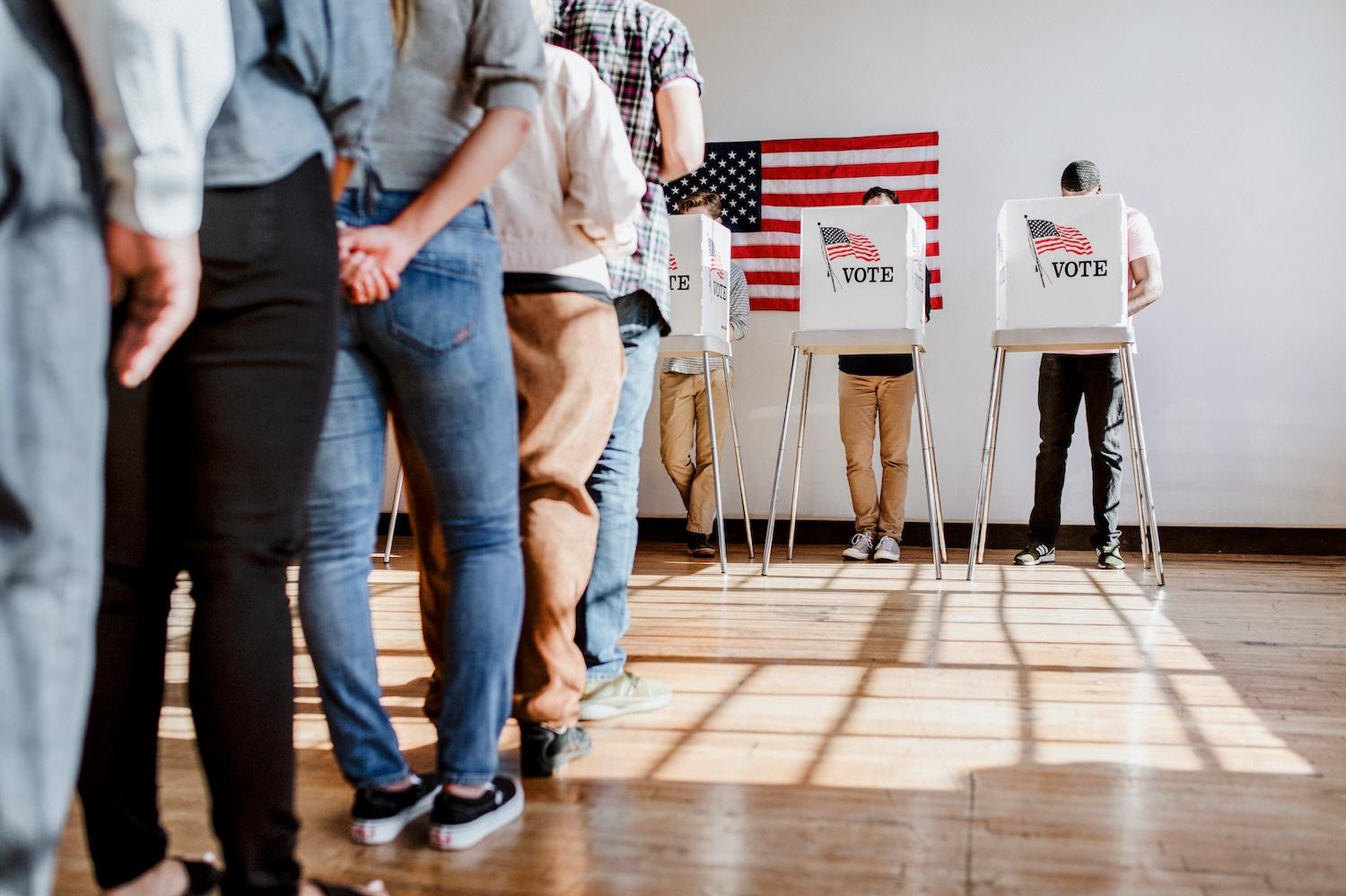
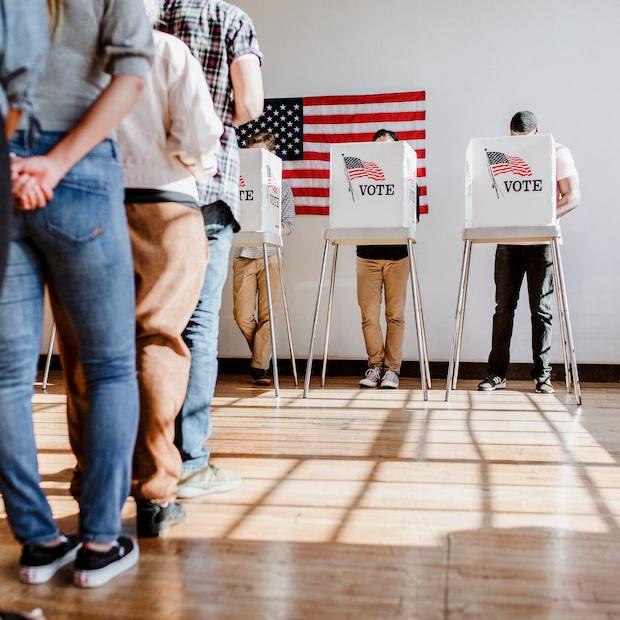
As the U.S. prepares to head to the polls in November, presidential candidates Kamala Harris and Donald Trump met for their first debate at the National Constitution Center in Philadelphia this week. (Image: rawpixel.com/Adobe Stock)
U.S. Vice President Kamala Harris and former U.S. President Donald Trump faced each other on the debate stage for the first time in Philadelphia last night. During the 90-minute session hosted by ABC News, the opposing presidential candidates squared off on key issues of importance to the American public, including the rising cost of living, reproductive rights and election integrity. Read on for every time they mentioned climate change and environmental issues, along with fact-checks and commentary from the TriplePundit news desk.
Moderators asked only one question about climate and environment during the presidential debate
The topic of climate change was only posed once in the presidential debate. While this may come as disappointing to some voters, it's fairly consistent with mainstream media coverage of climate change in the U.S. The major U.S. television networks — ABC, CBS, NBC and Fox — devoted less than 1 percent of their airtime to discussing climate change in 2023, according to the nonprofit Media Matters for America. Toward the end of the 90-minute time slot, ABC News anchor Linsey Davis addressed the candidates with the following:
“We have another issue that we'd like to get to that's important for a number of Americans, in particular younger voters, and that's climate change. President Trump, with regard to the environment, you say that we have to have clean air and clean water. Vice President Harris, you call climate change an existential threat. The question to you both tonight is what would you do to fight climate change?”
Vice President Harris had this to say in response:
“The former president had said that climate change is a hoax. And what we know is that it is very real. You ask anyone who lives in a state who has experienced these extreme weather occurrences who now is either being denied home insurance or is being jacked up. You ask anybody who has been the victim of what that means in terms of losing their home, having nowhere to go. We know that we can actually deal with this issue. The young people of America care deeply about this issue. And I am proud that as vice president over the last four years, we have invested a trillion dollars in a clean energy economy while we have also increased domestic gas production to historic levels.
"We have created over 800,000 new manufacturing jobs while I have been vice president. We have invested in clean energy to the point that we are opening up factories around the world. Donald Trump said he was going to create manufacturing jobs. He lost manufacturing jobs. And I'm also proud to have the endorsement of the United Auto Workers and Shawn Fain, who also know that part of building a clean energy economy includes investing in American-made products, American automobiles. It includes growing what we can do around American manufacturing and opening up auto plants, not closing them like what happened under Donald Trump.”
The former president did not mention climate change or the environment in his response, spending the one-minute allotted time criticizing the Biden-Harris administration's record on manufacturing jobs.
Our take: The framing of the question itself is noteworthy. While polling shows that young voters are the most likely to list climate change as a top issue, research shows it is important to voters across demographics. Even as the cost of living crisis looms large, more than a third of Americans list climate change as a top-three issue facing society, including 38 percent of baby boomers, according to research released by TriplePundit this summer. A report published by Deloitte this week also indicates it's a top-three issue for the majority of C-suite executives.
Despite voter concerns, Donald Trump did not take the opportunity to dispute or amend his 2016 statement that climate change is a hoax invented by the Chinese government. More recently, he said rising global temperatures would come with the benefit of "more oceanfront property."
Harris, on the other hand, directly referenced the impact that climate change already has on the American public. In the first eight months of 2024 alone, the U.S. experienced 20 weather and climate events with losses greater than $1 billion each, according to the U.S. National Centers of Environmental Information. Each of these events represents thousands of people whose homes were damaged or lost, and whose towns now face months or years of reconstruction.
The trillion dollars in clean energy investment Harris mentioned likely refers to provisions included in the Inflation Reduction Act and Bipartisan Infrastructure Law. While environmental groups have called them "the most ambitious environmental laws in U.S. history," fact-checkers at outlets including Atmos.Earth observe they don't add up to a trillion dollars in investment. That said, a key goal of the legislation is to stimulate private investments in clean energy that go above and beyond direct funding from the federal government, and it is unclear if Harris included private capital in her trillion-dollar total. It is also true that domestic U.S. production of oil and gas set new seasonal records in 2023, though overall greenhouse gas emissions tied to energy fell by about 7 percent.
Trump calls clean energy into question
While climate was only mentioned once, the U.S. energy system came up a number of times across the debate that are worth noting. In particular, former President Trump made some outlandish claims about the viability of clean energy, including:
“If [Harris] won the election, the day after that election, they'll go back to destroying our country and oil will be dead, fossil fuel will be dead. We'll go back to windmills and we'll go back to solar, where they need a whole desert to get some energy to come out. You ever see a solar plant? By the way, I'm a big fan of solar. But they take 400, 500 acres of desert soil. These are not good things for the environment that she understands.”
He later addressed Harris with the following:
"[Y]ou believe in things that the American people don't believe in. You believe in things like we're not going to frack. We're not going to take fossil fuel. We're not going to do things that are going to make this country strong, whether you like it or not. Germany tried that and within one year they were back to building normal energy plants. We're not ready for it. We can't sacrifice our country for the sake of bad vision."
Our take: There's a lot to unpack here. For starters, what is a "normal" energy plant anyway? A hundred years ago, a normal energy plant would have been powered by coal, but because coal is now the most expensive source of energy in the U.S., the use of coal power continues to decline. In short: Things change, which is why you'll rarely hear expert professionals using words like "normal" to describe matters of consequence to public life.
Similarly, the notion that the U.S., and the world more broadly, are "not ready" to source energy from renewables is not supported by data. Generating energy from solar and wind is now cheaper than oil and gas in most scenarios, and investment in renewables is set to double investment in fossil fuels globally this year. Germany in particular is a clean energy leader, supplying more than half of its power needs with renewable energy in 2023. (To be abundantly clear, Germany plans to continue to expand its use of renewable energy, but it did stop using nuclear energy last year.) In the U.S., zero-carbon sources made up over 40 percent of the energy mix in 2023.
Also worth noting: While the land footprint of renewables remains a challenge, most solar farms are far less than 500 acres in size, and advancements in both solar and green hydrogen technologies allow new projects to create more energy on less land.
Fracking emerged as a major topic of conversation, but do Pennsylvanians really care?
With the debate located in Pennsylvania, a key swing state where the candidates are polling neck and neck, the topic of fracking was mentioned more than twice as many times as climate change. Trump aimed to put the vice president on the defensive for her previous calls to ban fracking, saying: “Fracking? She's been against it for 12 years.”
Harris moved to clarify her position, saying she no longer supports a fracking ban:
"I made that very clear in 2020. I will not ban fracking. I have not banned fracking as Vice President of the United States. And, in fact, I was the tie-breaking vote on the Inflation Reduction Act, which opened new leases for fracking. My position is that we have got to invest in diverse sources of energy so we reduce our reliance on foreign oil. We have had the largest increase in domestic oil production in history because of an approach that recognizes that we cannot over rely on foreign oil."
Our take: It's true the Biden-Harris administration made no attempt to ban fracking. At the same time, the very notion that fracking — short for hydraulic fracturing, a method of extracting oil and gas by injecting a chemical solution into the earth — is popular enough in Pennsylvania to warrant multiples mentions across the debate is questionable.
While the state makes a lot of money from fracking, environmental groups say the claims around jobs are overstated, and no research shows that Pennsylvanians are in universal agreement on the practice being of benefit to them and their communities.
"Here’s the truth from someone who actually lives in Pennsylvania. Most folks, especially in areas like Philadelphia, Pittsburgh, and their suburbs where many voters reside, don’t really talk about fracking — certainly not as much as the big issues like the economy or abortion rights," longtime Philadelphia Inquirer columnist Will Bunch observed last week. (As a Pennsylvanian myself, I agree.) Bunch cited polls that range from 30 percent to 50 percent support for fracking across the Keystone State and referenced financial data that indicates fracked gas has only economically benefits one or two of the state's 67 counties.
The bottom line
For voters who consider climate change and the environment as they head to the polls, Trump didn't give them much to go on beyond continued support for fossil fuels. Major environmental groups including the League of Conservation Voters Action Fund, the Natural Resources Defense Council Action Fund, the Sierra Club and Clean Energy for American Action have already endorsed Harris for president, citing a long track record of support for reducing emissions and pollution.
“Whether holding polluters accountable as San Francisco District Attorney and California Attorney General, leading the charge on electric school buses in the U.S. Senate, or casting the deciding vote on the biggest investment ever in climate, clean energy and environmental justice and leading on climate on the world stage as Vice President, Kamala Harris has long been a climate champion,” Tiernan Sittenfeld, senior vice president of government affairs for the League of Conservation Voters Action Fund, said in a statement endorsing Harris.
What is your take on the candidates' environmental records, and what stood out most to you during the first presidential debate? Tell us about it here.
The Numbers Prove That Plastic Bag Bans Work
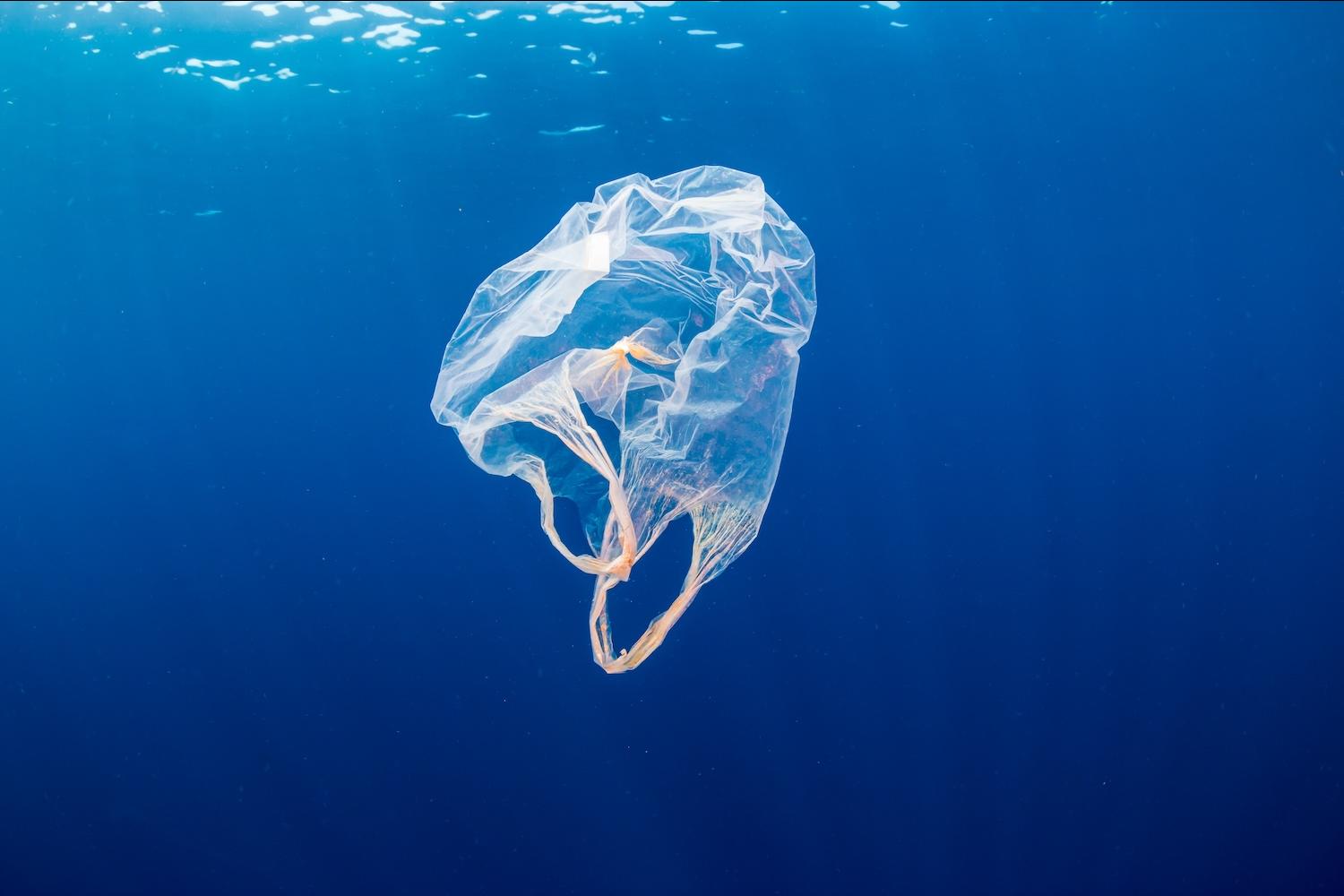
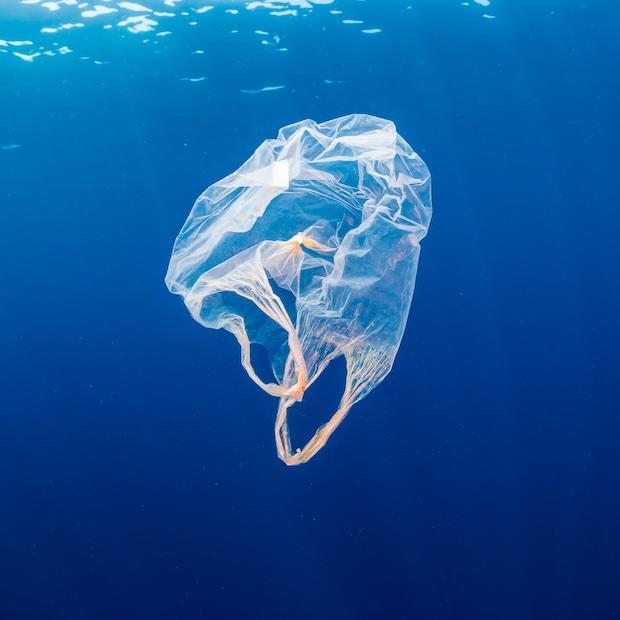
(Image: whitcomberd/Adobe Stock)
A new report from the Ocean Conservancy connects recently enacted statewide plastic bag bans to a significant drop in the number of plastic grocery bags cleaned up from beaches. The noticeable impact of law-making is a sharp contrast to the many years of effort spent urging individuals to voluntarily bring reusable bags when shopping.
Building support for plastic bag bans
In addition to providing data-driven support for new legislation, the Ocean Conservancy report also validates efforts from the business community to raise public awareness about plastic pollution, including manufacturers as well as public-facing industries like travel, fashion, sports and beverages. Even the music industry is beginning to take much-needed action to curb plastic waste.
The challenge, though, is to translate individual feelings into concrete action steps. After all, a volunteer beach cleanup does nothing to prevent the next wave of plastic litter. But awareness-raising and volunteer activities can help to build voter support for impactful legislation.
In the report, Conservancy scientists note that statewide plastic grocery bag bans covered only 12 percent of the U.S. population in 2020. Since then, new legislation has more than doubled that figure. Eleven states now have statewide bans, covering 25 percent of the U.S. population. Hundreds of municipal governments have also banned plastic bags, according to the report.
The research measures the impact of bag bans by tracking the number of bags collected by the Conservancy’s International Coastal Cleanup volunteers. Leaving aside a temporary surge in 2020 attributed to the COVID-19 pandemic, the results were spectacular.
Compared to the baseline years of 2013 through 2019, the volunteers collected 29 percent fewer bags in the 2022 and 2023 cleanup season, an achievement that the Ocean Conservancy directly attributes to new statewide legislation.
Public awareness works
The overarching message of the new report is that businesses can make a difference by continuing to build public awareness about ocean plastic pollution. That includes sponsoring volunteer activities, with the crucial step of collecting data and coordinating with data-driven conservation organizations like the Ocean Conservancy to measure what is collected over time.
Volunteers with the Conservancy's International Coastal Cleanup track their collected debris on the organization’s Clean Swell app or by hand. The totals go into a database kept by the Conservancy. “This database is the world’s largest repository of marine debris data and is used to inform scientists, conservation groups, governments, and industry leaders about ocean trash in support of plastic pollution prevention and advocacy efforts,” the Conservancy explained in its recent report.
The database contributed to new legislation in California and Florida in 2022, 2023, and 2024, covering balloon releases and foam products as well as plastic bags, the Conservancy reported. The data also informs the organization’s advocacy for an international plastic treaty.
Making a difference: The bipartisan infrastructure law and local economic impacts
Voter support can also make a crucial difference in other areas of ocean plastic remediation and prevention, as illustrated by a new funding recommendation of $5.2 million for the Conservancy funded through the 2021 bipartisan infrastructure law. The law passed with a Democratic majority in the Senate and skimmed through the Republican-lead House of Representatives with 13 Republican lawmakers tipping the balance.
The award is just one part of a $47 million carveout in the legislation for the Marine Debris Program of the National Oceanic and Atmospheric Administration, aimed at removing bulky marine debris.
Announced last week, the four-year Conservancy grant will focus on a variety of bulk waste including derelict fishing nets and large balls of discarded fishing gear, often called “ghost gear.” Though the Ocean Conservancy lists plastic bags among the top five most commonly found items on beaches, ghost gear poses a far more widespread threat to marine life. However, unlike beach litter, ghost gear is often found drifting or entangled out of public view.
“Ghost gear — much of which is made of plastic — is the most harmful type of debris for marine animals, and all large marine debris threatens marine life and sensitive ecosystems,” the Ocean Conservancy noted in a press announcement about funding. "This grant will allow us to go to remote locations heavily impacted by debris and deploy specialized equipment to remove items too large to remove by hand," Allison Schutes, the organization's senior director of conservation cleanups, added in a statement.
The economic case for reducing ocean plastic waste
Once the award receives final approval, the Conservancy will work with local stakeholders in Alaska, California, and Florida to remove ghost gear and other items in remote locations that require special equipment and training to access.
“Marine debris is not just a threat to marine life; it endangers the livelihoods and cultural practices of Indigenous communities who have stewarded these Arctic waters for millennia,” Barbara ‘Wáahlaal Gidaag Blake, the Conservancy’s VP of Arctic conservation, said in a statement. Ms. Blake is a member of the Káat nay-st/Yahkw Jáanaas (Shark House/Middle Town People) Clan in Alaska, where the Conservancy coordinates cleanup efforts with local tribes.
“The Arctic is a critical region for global biodiversity and plays a vital role in regulating our planet’s climate,” Blake said. “This funding from NOAA supports our collaboration with local tribes to remove this harmful debris, protect these essential ecosystems, and ensure the resilience of communities that are key to maintaining the health of our planet.”
Local stakeholders are also front and center in California, where the Conservancy will focus on helping lobster fishers in the Santa Barbara Channel and Channel Islands implement best practices to reduce ghost gear. The funds will also cover commercial fishers in the Port of Los Angeles. Similarly, the Conservancy will work with local organizations in Florida, where its director of Florida conservation, Jon Paul Brooker, takes note of “a powerful appetite” among anglers and other stakeholders to take meaningful action to reduce plastic pollution off their shores.
The voices of local economic stakeholders can become a powerful new force in support of new legislation aimed at cutting off the ocean plastic problem at the source. As demonstrated by the increasing number of U.S. states banning plastic bags, business leaders can keep the momentum by continuing to ensure the ocean plastic issue is top of mind in the public conversation.
How Kore Infrastructure Plans to Reduce Wildfire Risk by Turning Waste Into Energy
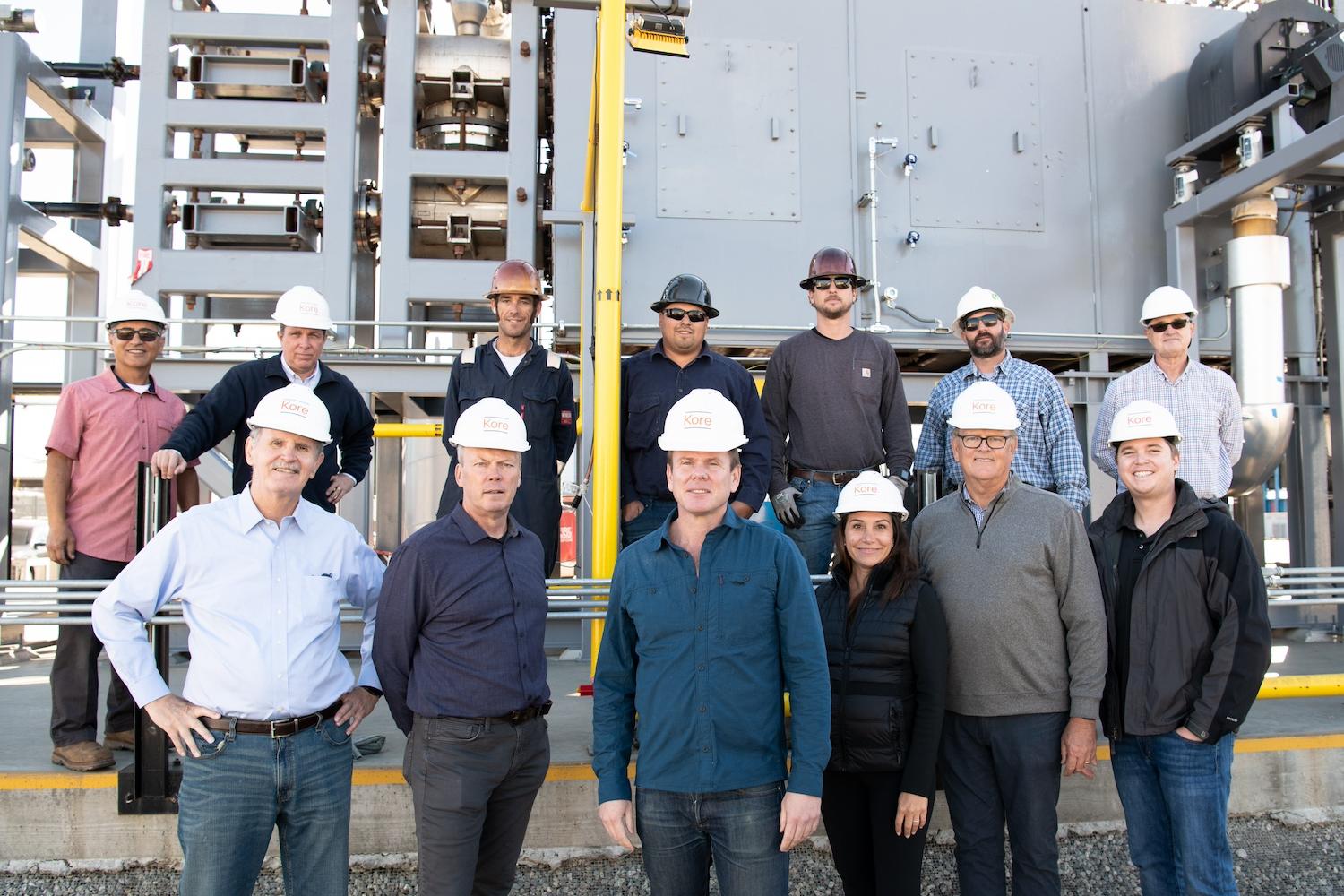
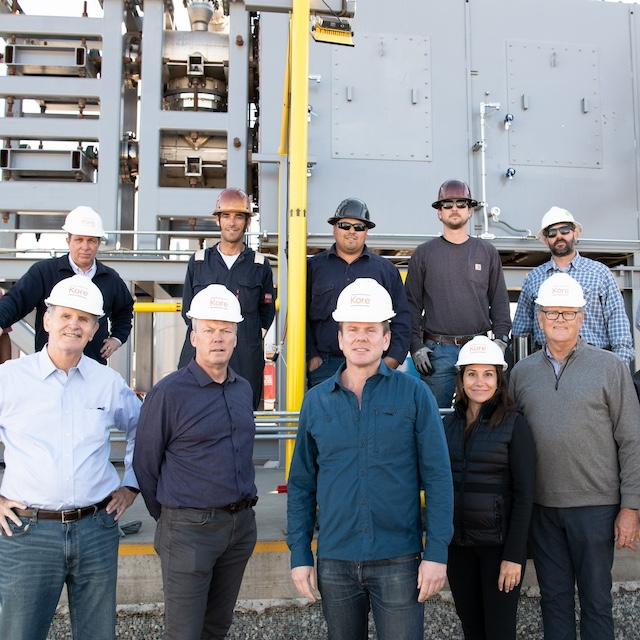
The Kore Infrastructure team. (Image courtesy of Kore Infrastructure.)
Could producing clean energy for the artificial intelligence (AI) boom also reduce wildfires? Kore Infrastructure’s founder and CEO, Cornelius Shields, hopes so. “Everyone wants to talk about AI [and] where's the power coming from,” he said. “We can play a part.”
Kore’s high-heat pyrolysis process converts biomass — such as agricultural prunings, nut shells and organic waste — into carbon-negative hydrogen, renewable natural gas and biogas. It keeps biomass out of waste streams while producing energy in a closed-loop system that powers itself. And by using dead, dying and diseased trees as feedstock, it could have the added preventative benefit of reducing wildfire risk.
Pyrolysis proving grounds
“Nobody wants to take a risk on something new until it's fully proven,” Shields said. “I think that's what it really takes to succeed. To bring in new energy, new infrastructure, you have to really be patient. You can't rush it to market.”
In 2022, Kore partnered with the Southern California Gas Company to produce clean fuel from organic waste to demonstrate how that energy could be made available to industries that are not easily electrified, specifically transportation. The project spared landfills 24 tons of trash every day it was in operation.
Shields credits some of the project’s success to Kore’s modular system. Instead of building a massive complex, the pyrolysis plants fit on just an acre, drastically reducing the cost of operation. That small size also makes the modular plants ideal for forest settings, where he’s eager to demonstrate that removing deadwood for processing can have a positive impact on wildfire prevention.
Converting wildfire fuel to energy
Kore is testing that theory in partnership with the Tule River Tribe in California, where tribe members are removing brush and deadwood near power lines. Left as is, all of that tinder creates an enormous wildfire risk. The 2018 fires in Paradise, California, began when downed power lines set the nearby national forest ablaze.
“There is evidence to support, based on controlled burns and others, that managing forests is not only healthy for the forest, but it does mitigate wildfires,” Shields said. ”In layman's terms, there's just less fuel … I truly believe that, once we get some early proof statements, integrating a technology like Kore’s into forest management will become a regular and known, established practice.”
Stepping in where there’s too much fuel for prescribed burns
Between irresponsible logging methods, the suppression of natural fires and overgrazing by livestock, North American forests have suffered mismanagement under the U.S. and Canadian governments’ tutelage. One way authorities tried to course-correct this is by intentionally setting controlled fires, which they call prescribed burns. Indigenous people have used intentional, controlled cultural burns for many millennia to manage the land, but federal and state fire suppression regulations have long prohibited and hindered the practice. However, due to the scale of the problem now, these burns often can’t be the only solution.
“With some of the factors that exist in forests, like dense areas of trees that have limited moisture, there's so much fuel,” Shields said. That makes burns more difficult to control.
There’s also the matter of how much carbon could be released at a time when the planet is already choking on our excess. “Pyrolysis is a non-incineration technology,” he said. “The emissions profile from a non-combustion process is far superior.”
In addition to producing clean energy out of potential wildfire fuel, pyrolysis also results in a substance known as biochar. Biochar is nutrient-dense and can be used in regenerative agriculture or reapplied to the forest floor to restore the soil in the same way that allowing deadwood to decay does, Shields said.
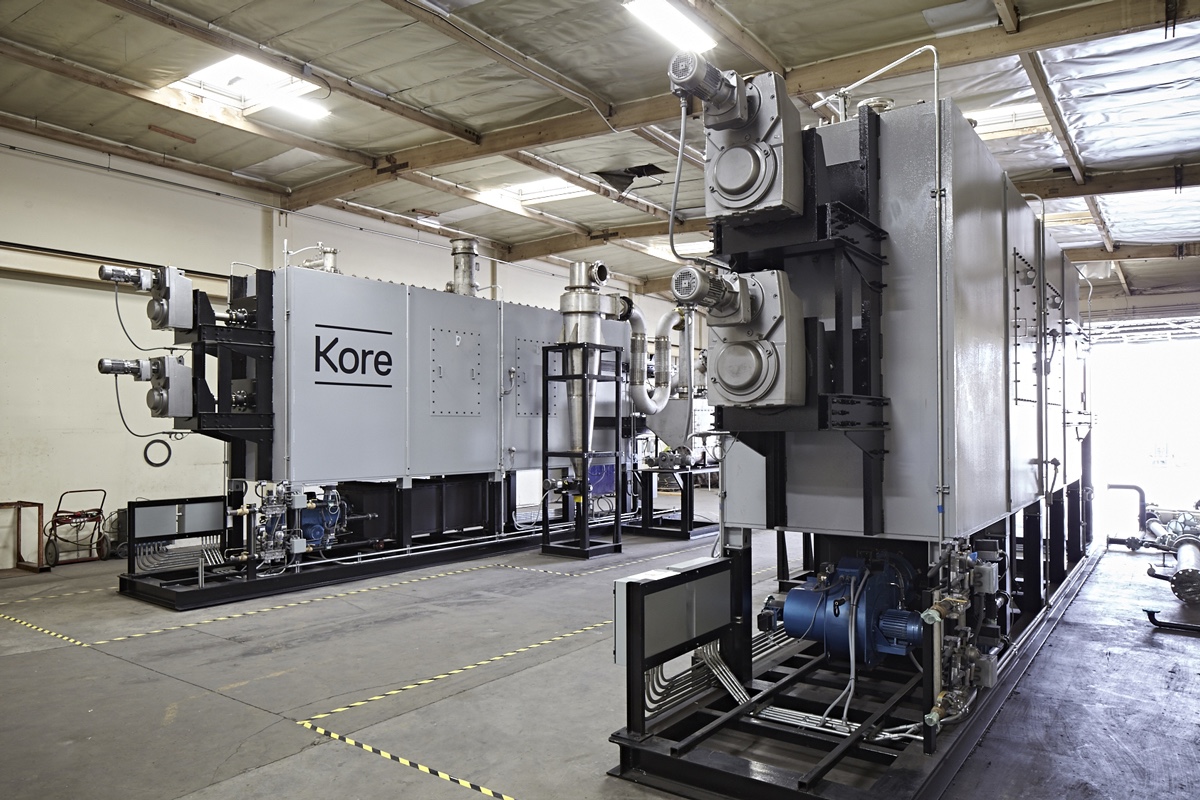
One potential pitfall stands out
Scaling the use of deadwood for conversion to clean energy doesn’t come without risk. While Kore handles the production of clean energy and biochar through pyrolysis, the inputs are provided by contractors. This leaves the harvesting side open to abuse by those entities.
“I think there's potentially a shadow side of it, as well,” Shields said. “Most of these contracts to manage the forest go to paper companies and logging companies. And you hope that they choose the dead and decaying ones, right? That's what we want to make sure [of], and that it's not an opportunity for them to … take other trees.”
Clear-cutting healthy trees, or including them in the feedstock, in the name of profit could override the benefits of forest-based pyrolysis. “Those that have the best interests of the natural world at heart, they have to have a seat at the table to make sure that doesn’t happen,” he said.
Partnerships with Indigenous communities, such as Kore’s collaboration with the Tule River Tribe, are therefore ideal. But the company is not able to control who forest management contracts are given to.
AI’s appetite for energy could spur clean energy tech
With data centers expected to require 160 percent more electricity in 2030 than they do today, the AI boom is threatening to cause a surge in energy use. Without enough clean energy options, this will likely lead to an increased reliance on fossil fuels, undermining global goals for decarbonization.
But Shields is optimistic that the tech industry will be a boon for carbon negative options like pyrolysis. “Their search for clean energy for AI, which is a fascinating turn of events, I think will actually accelerate technological solutions,” he said.
As such a solution, pyrolysis comes with the added benefits of keeping waste out of landfills and potentially protecting forests from wildfires. And unlike wind and solar, the fuels that are produced aren’t intermittent, which is a huge challenge for the energy transition, Shields said. “Overlap between profit and planet is so important for the development of these types of technologies."
From the Petri Dish to the Mine: These Microbes Dissolve Minerals
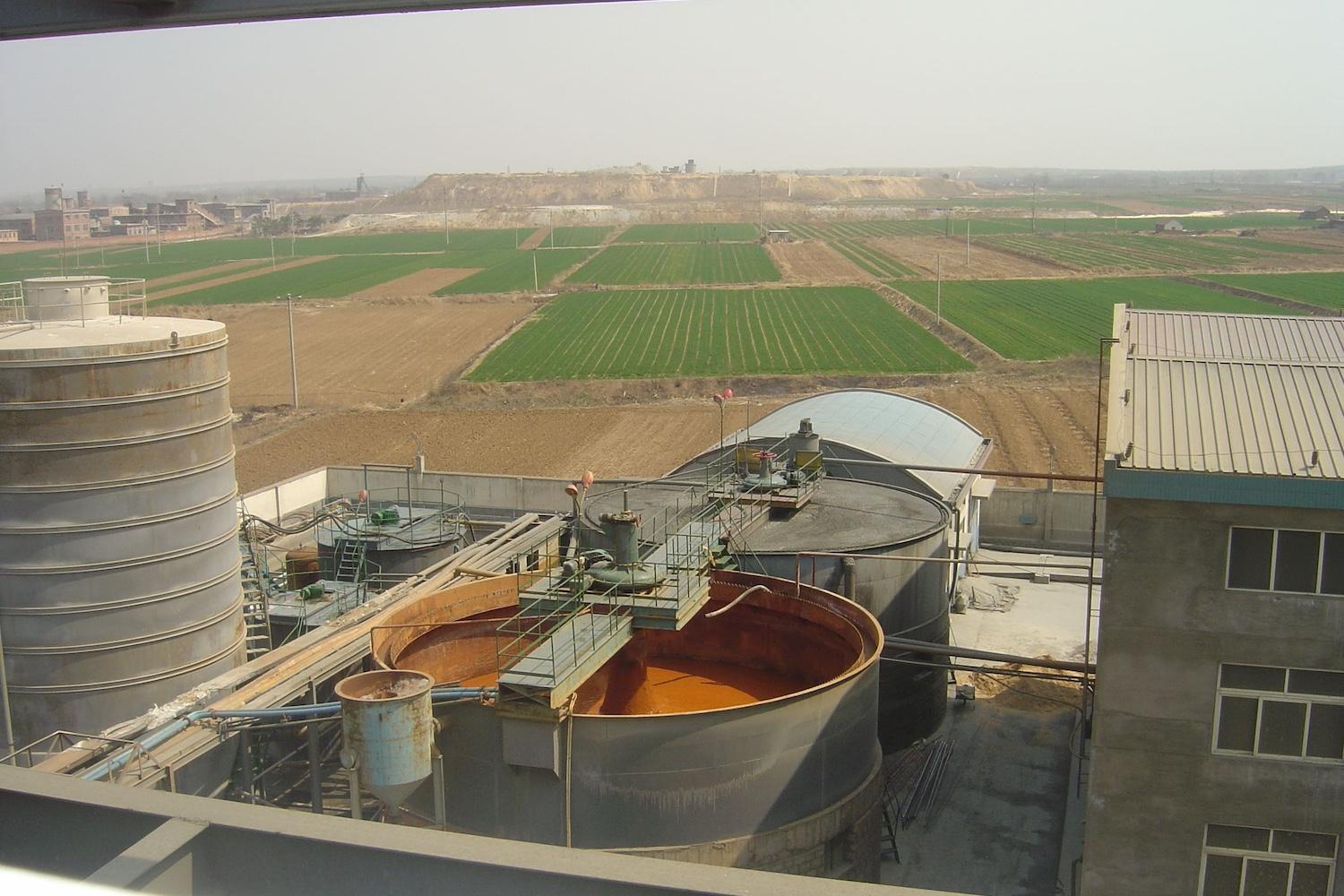
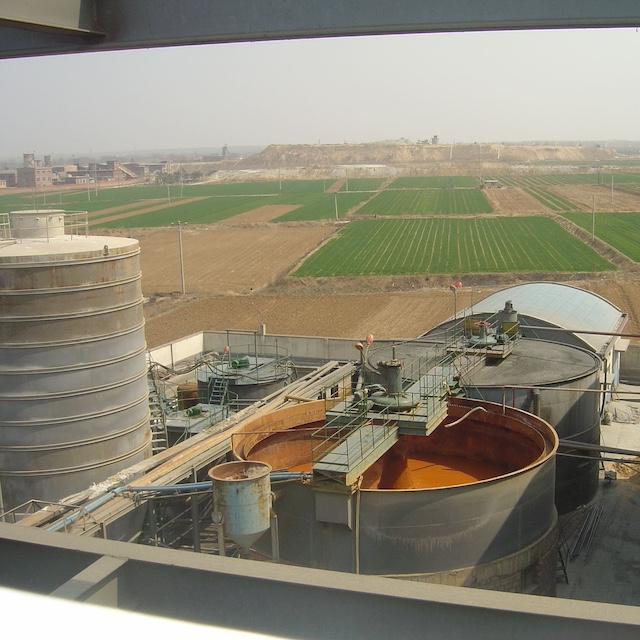
BacTech Environmental uses microbes to separate and stabilize impurities from gold ore, a process called bioleaching. (Image courtesy of BacTech Environmental.)
This article is part of our series on responsible mining solutions. The push for clean energy is fueled by growing demand for minerals. Conventional mining has a track record of harmful social and environmental impacts. Biomining is another potential solution to that problem.
Minerals are everywhere. Our blood is high in iron, bones are high in calcium, and a wide range of minerals like copper, nickel, and cobalt are essential to bodily functions.
We also need minerals to power the clean energy transition. We need lithium for rechargeable batteries, copper for almost all electric wiring, and a whole group of rare earth elements for other highly specialized jobs.
Don’t get nervous. I’m not suggesting we combine the ideas of the prior two paragraphs — let’s save mineral extraction from the human body for a dystopian sci-fi flick.
The point is that minerals are all around us and not exclusively in mine pits thousands of feet below the Earth’s surface. Minerals are in plants, seawater, air, garbage, and everything you see or touch.
The highest concentration of minerals is found in deposits beneath the earth’s surface, which is why we dig mines thousands of feet deep. But as those high-grade ores get depleted we have to start using low-grade ores, which means more work and higher costs to get less minerals. There are also substantial environmental and social costs from conventional mining that do not show up on the balance sheet.
“If we use traditional mining practices on low-grade ores, I think environmentally that will be horrible,” said Buz Barstow, assistant professor of biological and environmental engineering at Cornell University.
So, what can we do?
Call in the bugs
I don’t mean bugs in the creepy-crawly sense of the word, but rather the microscopic kind. One little guy on his own is utterly useless, but gather a few billion of his closest mates, and they can get into the nooks and crannies of low-grade ores, breaking them up to release the desired metal.
“Biomining provides about 15 percent of the world's copper and about 5 percent of the world's gold,” Barstow said.
At the world’s largest copper mine in Chile, a microbe solution is added to the low-grade ore waste piles. The bugs break up the ore and liquid copper, which filters down into a basin where they can collect and process the metal.
“It's actually called the world's biggest bioreactor. You can see this pile from space,” Barstow said. “It’s huge. It’s like 125 meters high, one kilometer long, and God knows how wide.”
One study suggests the surface area of the copper waste pad is about four square miles. That’s like 2,000 football fields, or one and a half Central Parks in New York City. And remember, the pile is about 400 feet tall.
While the bugs that work on this tectonic pile of rock are naturally occurring, the quantity and high concentration of them are not.
“I could not imagine that it is free of environmental impacts — it’s not mild in any way,” Barstow said. “But my feeling is that it will always be better than conventional methods. It’s probably one of the better choices that we have.”
This process, called bioleaching, produces byproducts like sulfuric acid that, if not handled properly, can spill into natural waterways. Managing environmental impacts is a point of intrigue for businesses and researchers, as is expanding this microbe’s palette beyond its steady diet of copper ore.
“The problem is that the bug is really good at working with ores that contain copper, but it's not very good with any other ore,” Barstow said. “And there are no other microbes in nature that can dissolve all the other types of minerals.”
Barstow and his team at Cornell are working to genetically alter and engineer new microbes that can be used to target the low-grade ores of other metals, beyond just copper.
This bug’s an expert gold miner
While gold isn’t vital to the clean energy transition, it plays a big role in making the capitalist world go round. And after catching wind of current economic uncertainties, some microbes decided to hedge their investments by acquiring gold.
One company that has had luck interacting with these gold-loving microbes is BacTech Environmental. The company uses microbes to separate and stabilize impurities from the gold ore, mainly arsenic.
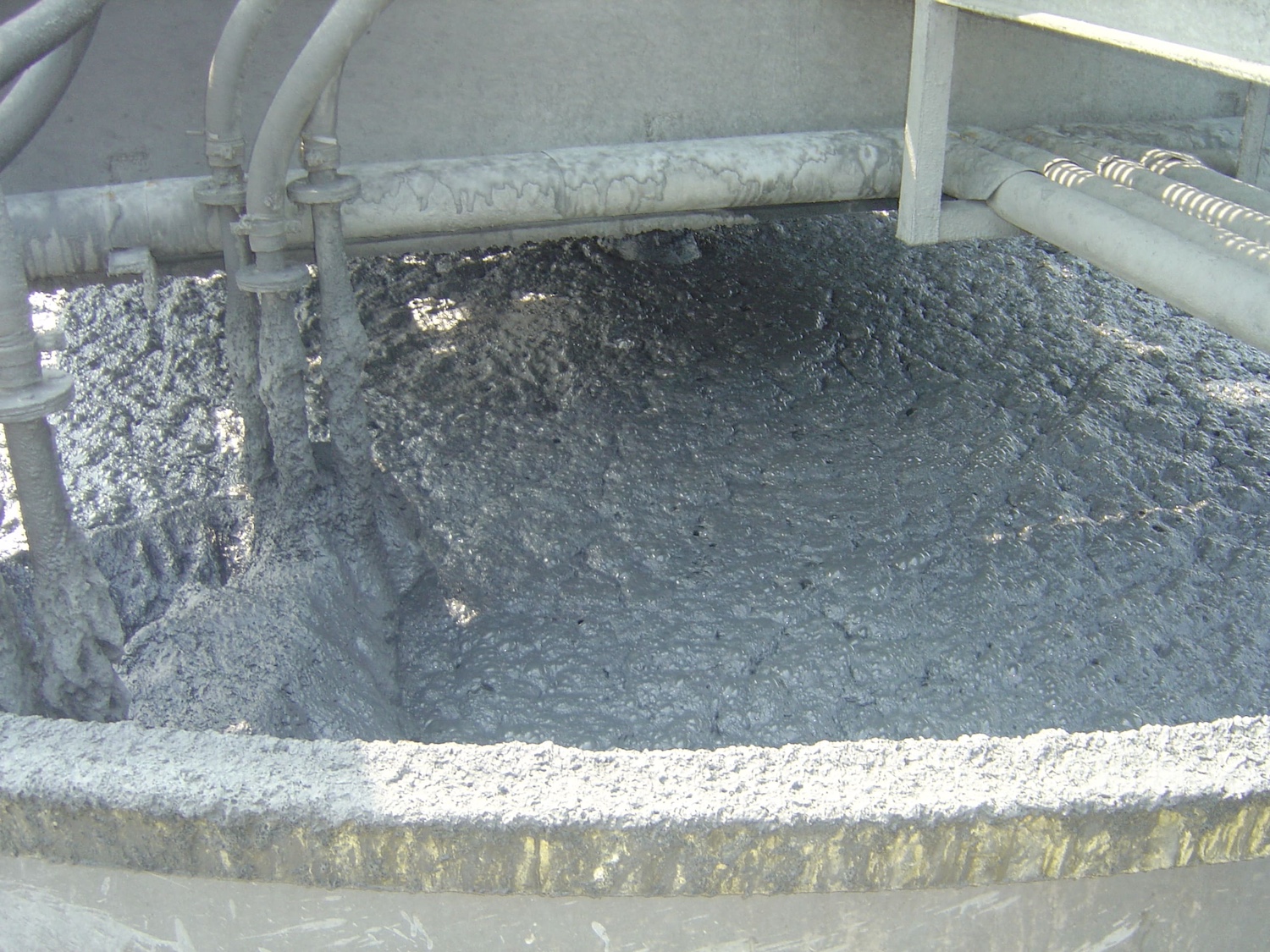
When gold is mined, arsenic and other minerals are often bound to the gold. These impurities reduce the value of the gold because it takes more processing to purify it. The purification process is chemical intensive and often involves cyanide, nature’s nasty kryptonite.
BacTech’s microbes don’t circumvent the use of cyanide in processing, but they sort of crack the gold ore open so that more gold can be retrieved with less chemical input. Because of this, the gold ore can be sold at a higher value.
BacTech’s CEO, Ross Orr, explained this situation using a case in Ecuador where the company is exploring development. “Chinese companies used to pay 65 to 70 cents on the dollar for gold here,” Orr said. “Then, the Chinese government imposed an import tax on high arsenic gold concentrates like they did in the copper market … This was passed on to the miners who are now getting 45 to 50 cents on the dollar. Using our biotechnology, we can get them back to what they were earning before.”
While BacTech’s solution does not drastically change the negative impacts of extracting gold ore from the earth, it does prevent arsenic from finding its way into tailings ponds and waterways — a common byproduct of downstream gold purification processes.
Other fascinating applications of microbial mining might
Amidst the depletion of high-grade ores and the heightened awareness around the negative impacts of mining, new companies are exploring the biomining world to find practical, economically viable and environmentally friendly solutions.
One of those companies, Transition Biomining, is looking at ways to improve copper bioleaching practices. It recognizes that every pile of rocks has its own little microbiome, or microbial society.
The company analyzes these distinct microbiomes and, given their composition, adds specific catalysts, or biostimulants, that are uniquely suited to invigorate the microbes.
“Our method works with these native microbial communities, enhancing their natural abilities rather than attempting to override or replace them,” said Sasha Milshteyn, founder and CEO of Transition Biomining. “By increasing resource utilization and reducing waste, we can make lower-grade ores economically viable to process with a lower environmental footprint.”
Another company, Maverick Biometals, uses artificial intelligence (AI) to create enzymes that break down the silicate crystal structures that make up many different rocks and minerals.
“Our AI model precisely fits the enzyme binding pocket to the specific shape of the crystal structure, like a hand fitting into a glove,” said Eric Herrera, CEO at Maverick Biometals. “This allows it to be hyper-specific in what it breaks down.”
Using this process, Maverick can extract about 99 percent of the lithium from minerals within 48 hours — all at a processing cost lower than conventional chemical methods. Maverick’s method creates a silica gel byproduct that is non-toxic and generally harmless. It plans to build a plant at a mine site in the coming years to produce lithium and another metal called strontium.
Can microbes power the clean energy transition?
Right now, no. In the future, probably, in part.
One big challenge these young companies face is the reluctance of the mining industry to embrace new technologies. Even when results show increases in efficiency and value, the industry can be hesitant to try something new.
“This hesitancy also makes it difficult to access the variety of ore samples needed for comprehensive research and development,” said Milshteyn of Transition Biomining.
All in all, it is a fascinating world at the microbial level and the applications of these microscopic crawlers are truly astounding. While they are not poised to take over the supply chain of all transition minerals, they are certainly willing to help. If you’re a microbe that eats nothing but copper ore, you ought to be thrilled with what the future has in store.
Cooler Rooms Might be the Solution to the Heat and Worker Health Crisis
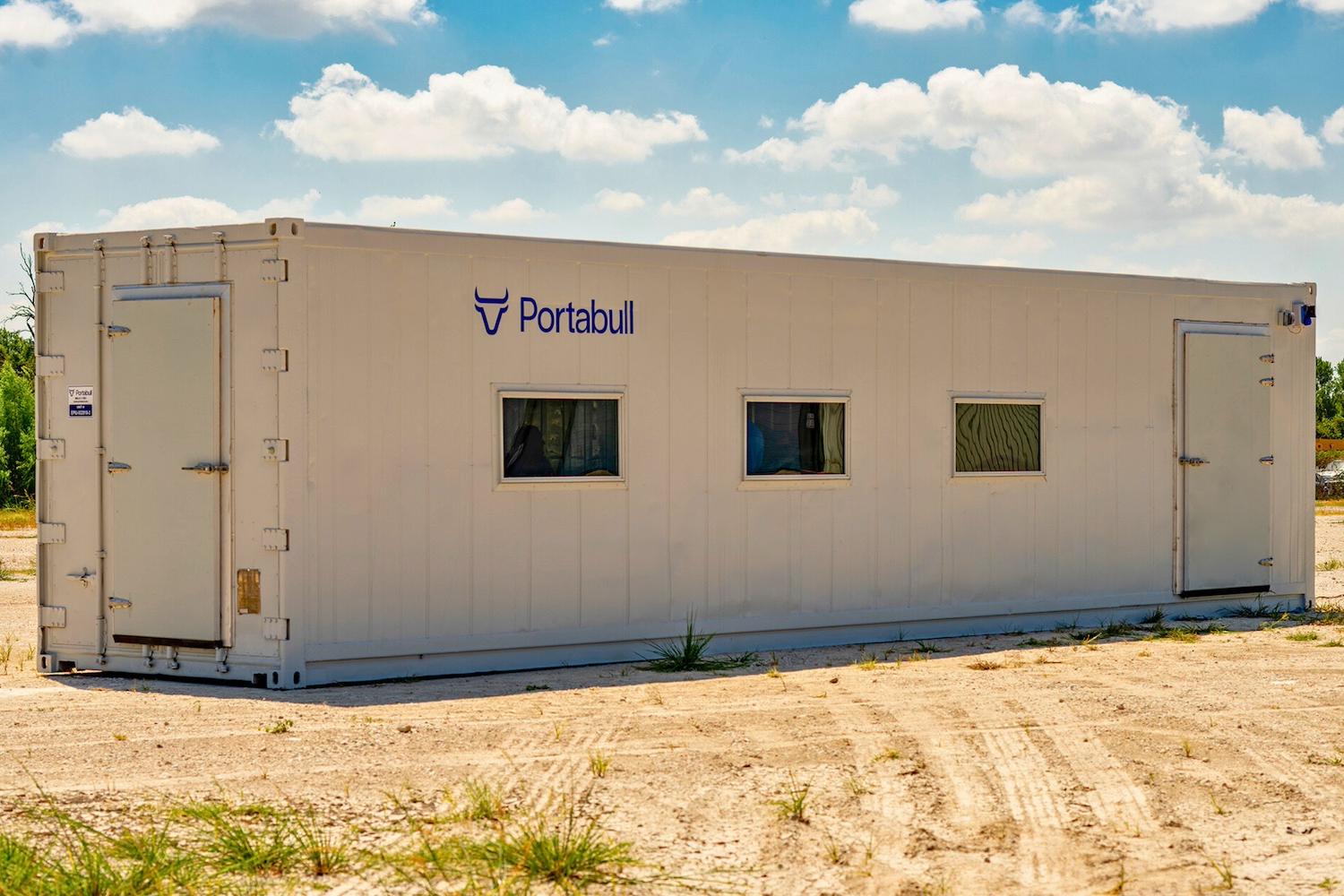
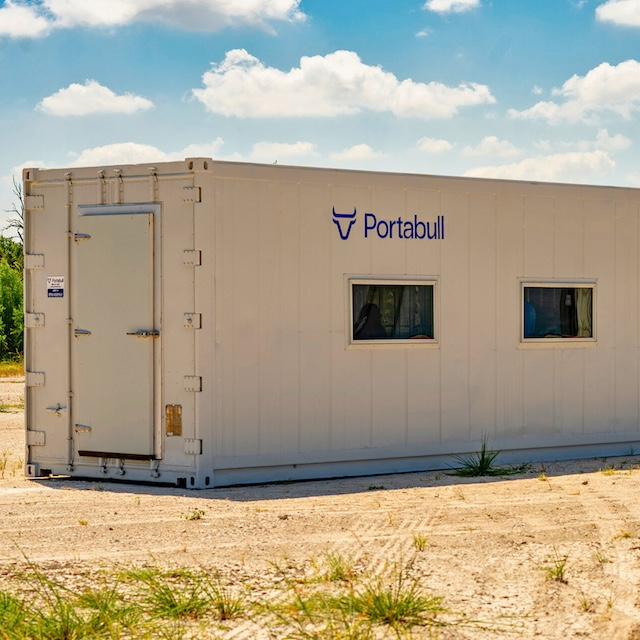
Portabull Storage's cooler rooms can be transported to all kinds of work environments to keep employees cool, even in high-heat environments. (Image courtesy of Portabull.)
As summer drags to a close for many, the heat brought on by the season may be a worry to put aside until next year. But in this changing climate, it will remain hot for many people regardless of the season. Some of the most vulnerable to the sweltering heat are those who work in the sun. Much of our essential products and services require outdoor work, so it is not easily abandoned, but extreme heat makes it riskier by the day.
Up to 2,000 annual workplace fatalities are estimated to stem from heat, alongside 170,000 heat-related injuries, according to the consumer advocacy nonprofit Public Citizen. Research shows cognition and task performance decrease when a worker is fatigued by heat, increasing the risk of workplace injuries. This is especially a concern for workers operating heavy machinery, but those incidents are not typically reported.
Portabull Storage aims to provide a solution with its new cooler rooms. The company is known for providing high-quality cold storage for temperature-vulnerable businesses like grocery stores and florists. Its new venture is building on that foundation to provide spaces where employees can cool down. These cooler rooms come with lighting, windows, emergency alarms and fold-down benches. They’re powered by an efficient electric system designed to conserve energy and cut costs for employers.
The 400-foot rooms slightly resemble shipping containers. They’re self-contained and designed to keep consistent temperatures between 50 and 80 degrees Fahrenheit, even in high-heat environments. The design allows employers to transport these portable havens to different places with all types of terrain, making them an option in the most remote, unlikely work environments.
“Today, employees in high-heat conditions only have access to makeshift or inadequate cooling solutions,” John Herman, Portabull’s president, said in a statement. “Athletic teams and construction workers struggle with open-air cooling tents, while heavy manufacturing employees might be forced to use subpar misters. Even oilfield workers, who are especially vulnerable to increasingly high temperatures, often only have access to ‘cool down’ trailers that are exposed to the elements.”
The labor force is a highly underrated but integral aspect of any business and without safe temperature regulation in this oppressive heat, it can dwindle. Successful businesses understand that employee safety, health and contentment are pivotal. “Every organization is only as healthy as the people within,” Herman said. “If employees regularly work in hot conditions, keeping them cool is a huge part of keeping them healthy.”
Air conditioning and heating are fast becoming a large part of climate adaptation. One company that has grasped this is a South Texas logistics port called Rockport Terminals, which uses the new rooms.
“Portabull’s cooler room solution is superior to other alternatives,” Ross Stevenson, Rockport Terminals CEO, said in a statement. “It has been critical to the success and safety of our workforce at the terminal.”
The rooms' design allows them to maintain a consistent temperature despite the heat of the environment. The same insulation technology used to create refrigerators and coolers is engineered into the design of these cooler rooms to preserve the internal temperature. It’s an effect you can’t get through putting a few fans or an air conditioning unit into a trailer. Preserving internal energy also contributes to the rooms’ energy-saving capacity. The unit ultimately exerts less power to keep the rooms cool, due to the limited effect of heat on the outside in raising or lowering the internal temperature.
Temperatures continue to rise as greenhouse gases warm the atmosphere, and the need for cooling options for occupational workers has become crucial. This new cooler room solution by Portabull is likely to be one of many in a situation that is growing more dire and hotter by the day.
No Kid Hungry Serves Up Summer Meals With Help from CEOs
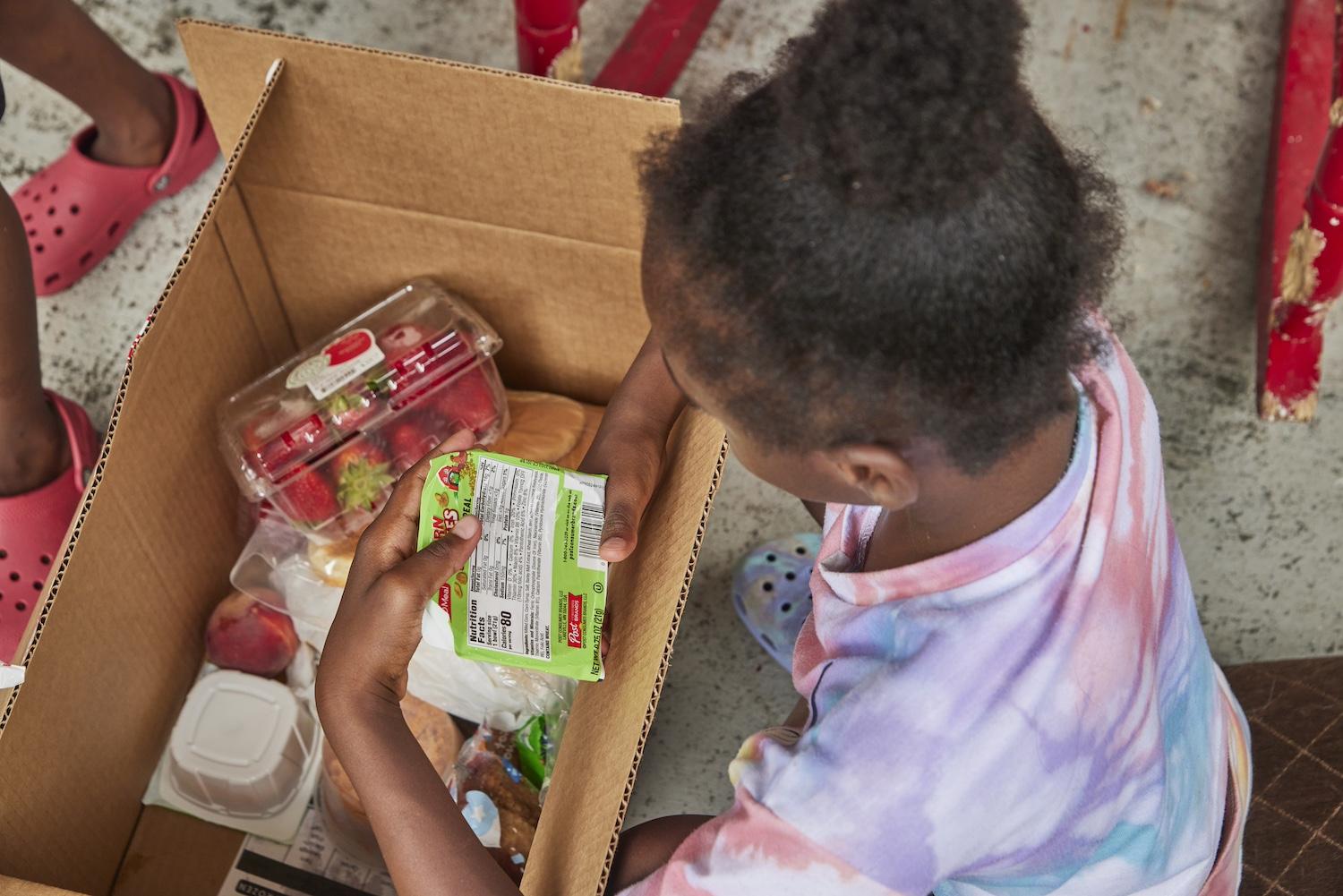
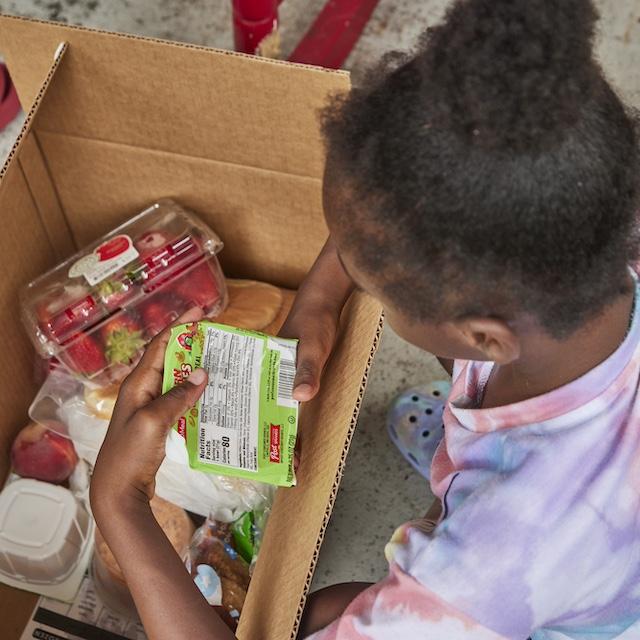
A student in Burke County, Georgia, opens a box of food they received from the recently-expanded summer meal program. (Image courtesy of No Kid Hungry.)
School meal programs are an essential part of fighting child hunger in the U.S., and the summer months are extra tough for the 20 percent of children who already don’t have access to enough food. Additionally, 41 percent of parents report having a hard time providing enough food during school breaks. While summer meal programs aim to help bridge that gap, only one in six eligible children benefit from it. That’s where the No Kid Hungry campaign comes in with its CEO Pledge to End Summer Hunger and the goal of raising participation in summer meal programs from 2.8 million children to 30 million.
“When you're eight, 12, 14, and your belly is empty, that's just incredibly difficult,” Charles Watson, the CEO of Tropical Smoothie Cafe, told TriplePundit about his participation in the pledge. “So those were the things that really hit me hard, in terms of, we've got to get involved here.”
As the head of a food service company, the program is also important for business, Watson said. “These are my future employees, and they're my future guests, right? They're both incredibly important people to me … Who doesn't believe that kids are the future of the country?”
Changes to the summer meal program
Developed in 2010, No Kid Hungry is a United States-based campaign run by the nonprofit Share Our Strength, which was created in 1984 as a response to the famine in Ethiopia. No Kid Hungry is currently focused on raising $50 million over the next three years to help implement bipartisan legislation passed in 2022 to expand the summer meal program, Anne Filipic, CEO of Share Our Strength, told 3p.
“It's the biggest investment and really [the biggest] change to nutrition programs in the country in 50 years,” Filipic said. The money raised will go to schools, local organizations and state agencies to ensure they have the funds to put the expanded program into action.
Lack of funding and accessibility are the primary reasons most children who qualify for summer meals don’t get them. Children are automatically eligible if they receive free or reduced-price school lunches or certain public benefits such as the Supplemental Nutrition Assistance Program (SNAP). Families who do not participate in these programs but meet the income requirements can apply separately.
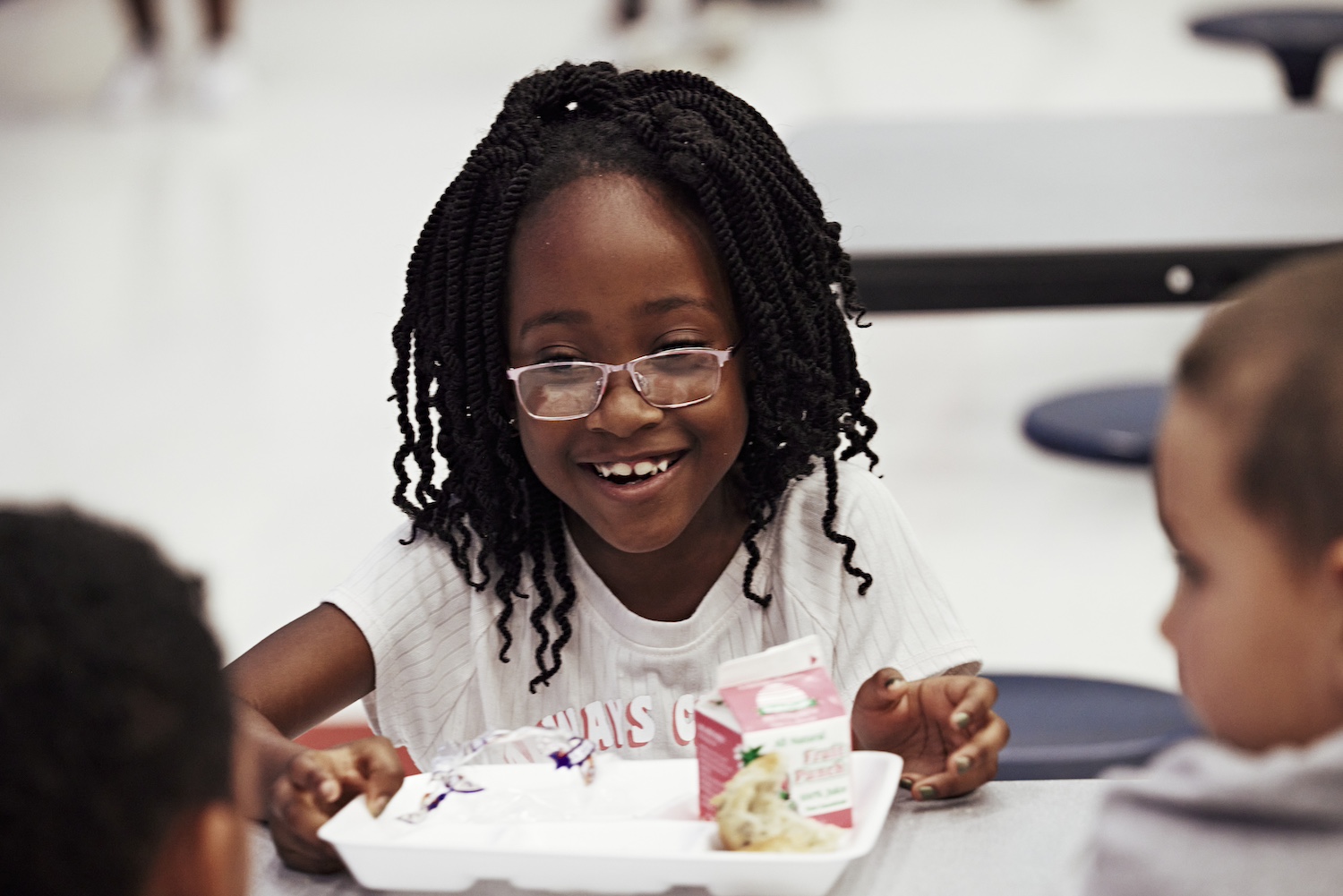
Prior to the new legislation, the only way to access the summer meal program was for children to show up in person at designated meal sites and eat the lunches there. This situation created a burden for parents and caregivers, and it excluded children who didn’t have the means to travel to a meal site daily.
“I think everyone understands that that can be challenging for anyone but particularly if you're living in a rural area, if the meal site was 20 miles away, your parents are working, there's really no way that that kid can go,” Filipic said. “To now be in a place that those meals can be delivered, that they can actually be picked up, and you can pick up multiple meals at a time just completely transforms what it means in terms of the accessibility of this program.”
Filipic highlighted the example of Caroline County, Maryland, where she was able to ride along on deliveries to area with high levels of eligibility. “We were actually able to go door to door and hand out meals,” she said. “It’s very clear how that is just a total game changer and what that means for those kids, as opposed to having to travel miles and miles to get those meals.”
In addition to deliveries and multi-lunch pickups, the expanded summer meal program provides $40 per child for each month of summer — a total of $120 in grocery benefits. The funds, called Sunbucks, are available on electronic benefit transfer cards and can be used to buy cold foods and snacks the same way SNAP benefits are used.
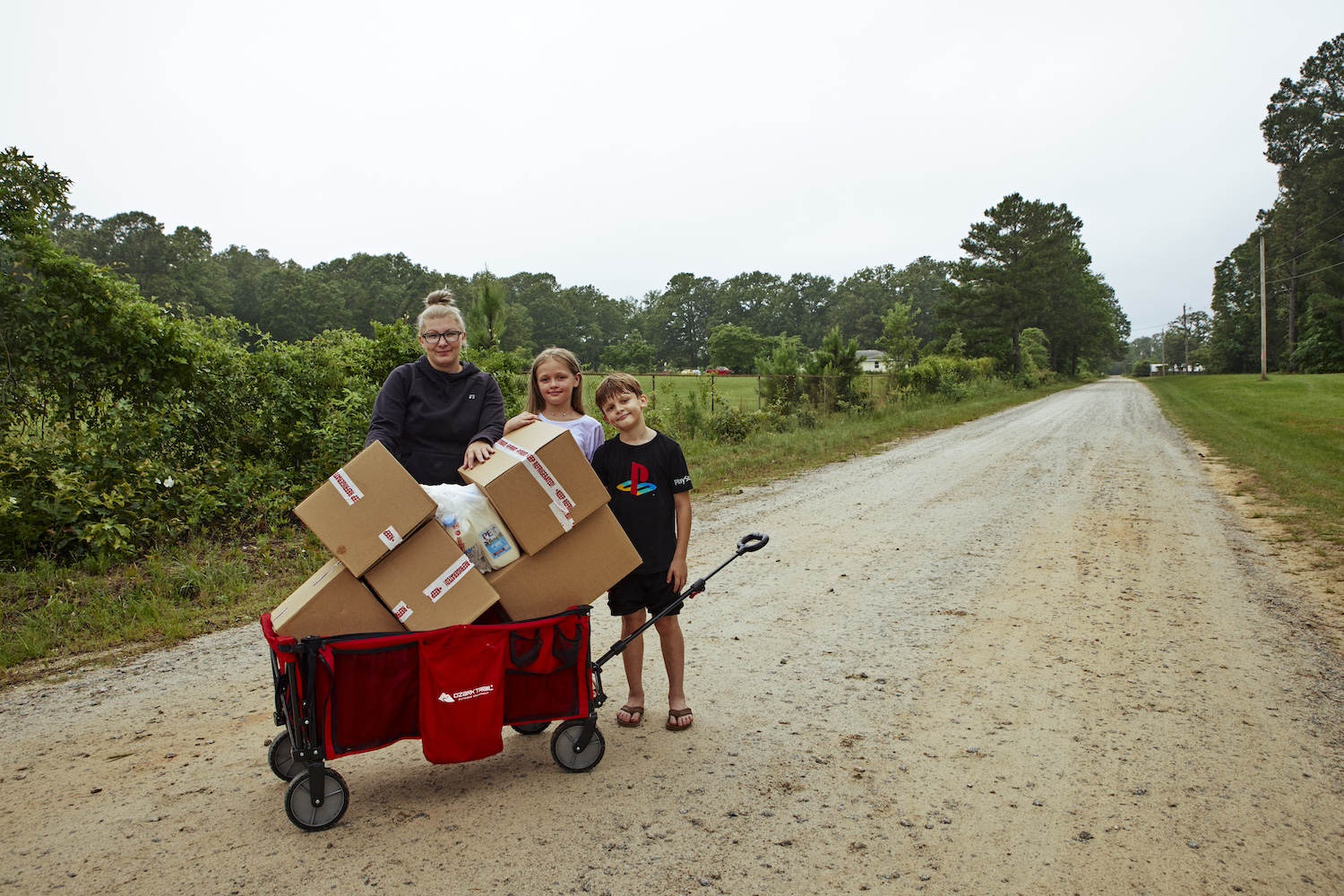
Pledges and fundraising
As of July, No Kid Hungry has given almost $4 million to 215 partners nationwide, Filipic said. The funds are used to pay delivery drivers and buy equipment like delivery trucks and coolers, which will help provide more than 6 million meals to kids living in rural areas. So where are those funds coming from?
“Most CEOs, myself included, are going to make a personal donation,” Watson said. Tropical Smoothie Cafe also mobilizes its customers to give by rounding up or donating at the register, but the bigger dollars come from tapping into brand funds.
“[Consumers] want to see brands that are giving back," Watson said. "We have a smoothie on our menu called the Sunshine Smoothie, so we thought it was very appropriate for a Sunshine Smoothie to donate $1 of every one of those that we sell to No Kid Hungry … We have a three-pronged approach, but for every brand, they have different ways of going about it.”
Tropical Smoothie Cafe has raised more than $2.6 million since last summer, an achievement that the organization is very proud of, Filipic said. As a result, more brands and CEOs want to follow Watson’s lead.
“I think that point is really important because when I think of Jack in the Box, yes it's a brand, but to me, it's Darin Harris,” Watson said. “That's a guy I know who also does what I do in the restaurant business … Like any industry, we talk. We push each other on things … You get the groundswell of a CEO pledge. You get that good pressure [to participate].”
Limitations of the summer EBT program
Twenty-one million children in 37 states, five territories and three tribal nations are eligible for the Sunbucks EBT program this year, Filipic said. That number increases to 29 million when all 50 states participate.
But 13 states chose not to opt into the program, including Alabama, Mississippi, South Carolina, Georgia, Florida, Texas, Oklahoma, Iowa, Wyoming, South Dakota, Utah, Idaho and Alaska. All are led by Republican governors who claimed their state could not afford to distribute the federal funds or voiced opposition to so-called welfare benefits.
“What we focus on as a nonpartisan organization is that this is about kids,” Filipic said. “When a new policy is rolled out, often what people are focused on is the politics of it. But I think our experience is that as families start to benefit, as children start to benefit, as [they] realize that this can make the difference for a child in being fed in the summer and then starting the school year healthy and strong and ready to learn, as we continue to implement this program and lift up these success stories and highlight what it has meant for kids, the more … states will get on board.”

Collective action makes the difference
Childhood hunger in the U.S., and hunger in general, is the result of multiple factors, from poverty and a lack of sufficient safety nets to rising food prices to food deserts in vulnerable communities. Solving the problem therefore requires a multipronged approach. Collective action and summer meals can go a long way to help.
“This is what it will take to end childhood hunger in this country,” Filipic said. “A wide range from nonprofit organizations to policymakers to industry CEOs saying, ‘What can we do collectively … to make sure that no child goes hungry in this country?’”
These Companies Respect Their Employees' Right to Organize
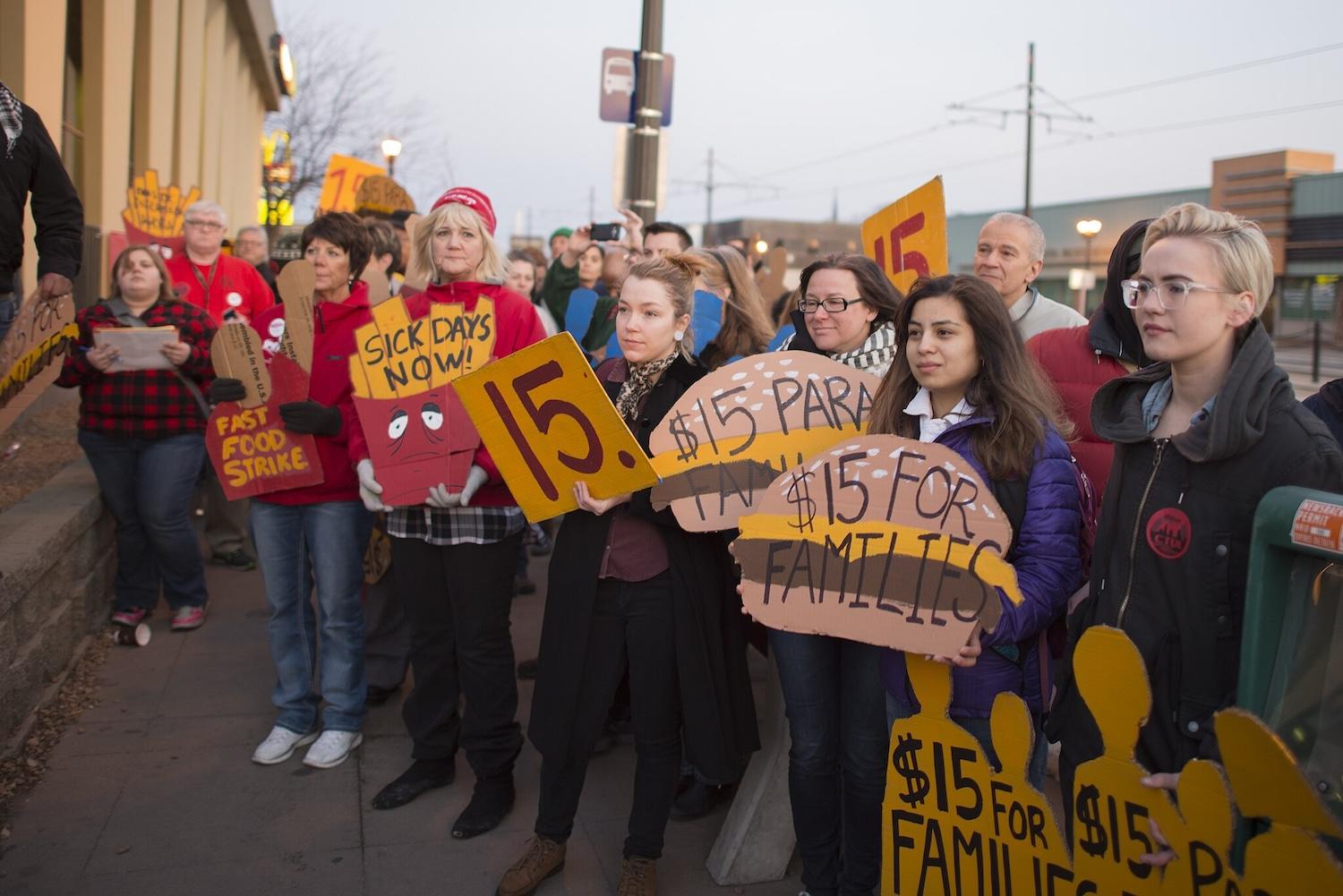
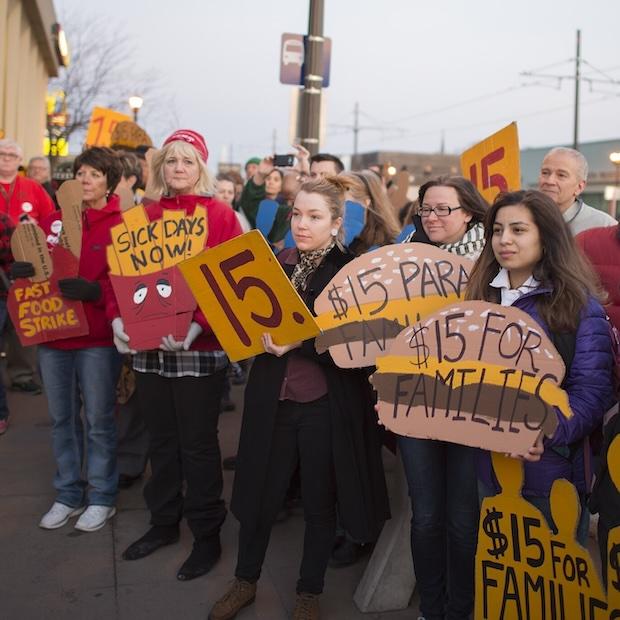
Fast food workers in Minnesota strike for better pay and benefits. (Image: Fibonacci Blue/Wikimedia Commons)
While the U.S. Labor Day holiday honors the contribution of all workers, its roots trace back to the organized labor movement of the late 1800s. Turn-of-the-century organizers fought to restrict child labor, ensure vital safety and healthcare provisions for workers, and establish a five-day workweek, among other objectives.
At the time, most people worked for more than 10 hours a day, six days a week, and companies were under no obligation to pay fairly or provide benefits. The movement to change that was fiercely opposed by employers. Workers who organized strikes and formed unions were met with deadly crackdowns in a period often called the Labor Wars. While fewer of their successors in the mid 20th century faced violence, many were fired or lost their benefits for trying to join a union.
Fast forward to today: The U.S. minimum wage hasn't increased in 15 years, and labor organizing is reaching new peaks across the nation, with more than 450,000 workers going on strike last year. Most employers fought the push toward unionization among their employees, and experts blasted several top companies for what they called "old-school union busting" tactics like retaliating against or firing workers who attempted to organize.
Many companies oppose unionization by default, even through more subdued means such as distributing anti-union material to employees or holding mandatory meetings where leaders discourage their teams from joining a union. U.S. employers break federal law in around 40 percent of all union elections, according to the Economic Policy Institute. But not all employers take this approach, and research suggests that unions can actually be good for business by reducing turnover and improving worker safety.
The U.S. Department of Labor encourages companies to respect their employees' right to organize by committing to stay neutral in union campaigns or voluntarily recognize a budding union among their workers. The following companies did just that.
Microsoft opts to accept unions among subsidiary companies
When Microsoft purchased the video game company Activision Blizzard in 2022, employees at one of its subsidiaries called Raven were in the midst of a heated union battle. After the nearly $70 billion deal, Microsoft said it would stay neutral if any of Activision's eligible employees wanted to unionize, and many have already moved to do so. Autumn Mitchell, a quality assurance worker who was part of the organizing campaign, called Microsoft's neutrality stance "an absolute gift" in an interview with workplace reporter Noam Scheiber of The New York Times. His analysis of why Microsoft, once notorious for ruthlessness in overcoming competitors, moved to accept unions is a fascinating read that's well worth a look.
Patagonia stays neutral as Nevada employees vote to unionize
When workers at a Patagonia outlet store in Reno, Nevada, organized a campaign to unionize earlier this year, the company committed to stay neutral and stuck with it, leaders at the United Food and Commercial Workers union told the Huffington Post. Employees ultimately voted to unionize, a first for the company. “So far, it’s encouraging to see Patagonia stay neutral," Nick Helmreich, a worker at the Reno store, told HuffPost in March. “We’re only starting out, but it’s an optimistic sign that they’re letting us, the workers, decide our future.”
Major League Baseball voluntarily recognizes union among minor-leaguers
In 2022, a group of minor league players started a campaign to unionize with the MLB Players Association, and rather than fight it, the Major League organization opted to voluntarily recognize their efforts and push union negotiations through. The 5,000 minor leaguers in the union said they often spent up to 80 percent of their paychecks on the team hotel alone and that a seat at the bargaining table will help them to push for better pay and benefits.
U.S. Publishers Push Back Against Book Bans


The Diary of Anne Frank is among the titles pulled from school libraries in Florida following legislation passed in 2023. (Image: Kelly Sikkema/Unsplash)
Last week, a group of leading U.S. publishers launched a lawsuit challenging book bans in Florida and appealing for a restoration of professional standards and evidence-based decision-making in state law. If the publishers succeed, they will set the stage for other businesses and organizations to fight back against new restrictions to constitutional rights that impact public life and corporate policies.
A book ban by any other name
State and local book bans have proliferated across the U.S. with the purported aim of protecting minors from sexually inappropriate materials. Florida Gov. Ron DeSantis emerged as a leading advocate for book bans, though he prefers to reference parental empowerment instead.
“Florida does not ban books,” a statement from the governor’s office reads. “Instead, the state has empowered parents to object to obscene material in the classroom.”
That observation is more than a little misleading. Freedom of speech is guaranteed by the U.S. Constitution, and parents have always been empowered to object to anything. The issue is what happens afterward.
The Florida law, HB 1069, stipulates that any objection over “sexual content” triggers the removal of the given reading material from classrooms and libraries within five days, followed by an unspecified period for resolution of the complaint. It does not require an objector to possess any qualifications for describing the complex issue of sexual content.
As a result, books can be taken out of circulation indefinitely based solely on the personal opinion of a single individual.
Book bans and social vigilantism
The seamless transfer of personal opinion to state-ascribed action steps is the essence of social vigilantism, a term used by scholars to describe the “tendency to believe one's beliefs are superior to others' and to attempt to impress one's beliefs onto others.”
Social vigilantism is often disconnected from facts and information. In a recent Kansas State University study published in the journal Personality and Individual Differences, for example, researchers link social vigilantism to “greater tendencies to disseminate and defend one's beliefs, regardless of how well-informed those beliefs are.” The same study noted that social vigilantism is “positively correlated with social dominance orientation, right wing authoritarianism and conservatism.”
In not so many words, that is precisely the focus of the new lawsuit against Florida's HB 1069, jointly announced on August 29 by Penguin Random House, Hachette Book Group, HarperCollins Publishers, Macmillan Publishers, Simon & Schuster, and Sourcebooks. “Hundreds of titles have been banned across the state since the bill went into effect in July 2023,” the publishers state.
They assert the Florida law violates a 1973 Supreme Court obscenity test. The decision, Miller v. California, requires the opinion of "the average person” to be assessed in reference to wider community standards and state law around obscene speech, along with an assessment of the entire work — not just a line or two — to determine if it lacks “serious literary, artistic, political or scientific value.”
“Serious” is the key word. Seriousness denotes a comparative determination informed by a range of works in public circulation. It sets a far more rigorous standard for removing material from a school library than HB 1069.
“The lawsuit focuses on restoring the discretion of trained educators to evaluate books holistically to avoid harm to students who will otherwise lose access to a wide range of viewpoints,” the publishers assert.
From personal opinion to evidence and expert insight
The effort to discredit professional insights into key issues of public concern is nothing new. For example, the pro-tobacco campaign of the 1990s, widely attributed to the influential lobbying organization Heartland Institute, seeded the public conversation with doubt over the scientific consensus on the health impacts of smoking. By the early 2000s, lobbyists employed a similar effort to undermine the consensus on climate science.
When the U.S. Supreme Court overturned Roe v. Wade abortion protections in 2022, the Republican-appointed majority ignored evidence submitted by medical professionals and other experts in favor of an unschooled assertion that impacts of harm were impossible to measure.
LGBTQ+ rights have also fallen afoul of anti-professional sentiment, as new state laws deny health services to certain people while ignoring the ample evidence supporting gender-affirming care. The torrent of fact-free allegations of voter fraud that emerged in the run-up to Election Day 2020 cultivated a mini-industry of inexpert “investigators," fanned the flame of the violent insurrection of 2021, and continues to threaten elections today.
By insisting on evaluation by trained professionals, the publishers attacked the very foundation of public policy measures that rely on social vigilantism instead of verifiable information. It remains to be seen if they succeed in court, but the movement to seek constitutional protection for discretion, including professional discretion, shows signs of growing.
Business coalition takes aim at another controversial state law
In the corporate environmental, social and governance (ESG) movement, for example, last week the American Sustainable Business Council took the unusual step of confronting Texas Comptroller Glenn Hegar and Attorney General Ken Paxton in court. On August 29, the business coalition filed a lawsuit suit against the two officials regarding their enforcement of SB 13, a state law intended to obstruct firms from following ESG investing principles.
“Among ASBC’s many projects are efforts to encourage sustainable investing and sustainable business practices. These are all cornerstones of the modern Texas economy. Yet SB 13 takes aim at, and punishes, companies that speak about, aspire to, and achieve this goal,” the group alleges.
To the extent that modern corporate sustainability practices are based on data, evidence, auditing and accounting — and they are — the ASBC lawsuit also cuts to the heart of anti-professional sentiment.
The suit is also notable because many firms have chosen to address anti-ESG threats simply by continuing to follow the same principles without referring specifically to “ESG.” Some business leaders grappling with a new wave of legislation and lawsuits against corporate diversity, equity and inclusion policies adopted a similar wait-and-see attitude.
However, corporate leaders may need to take aggressive action on intrusive legislation before the damage is done, and leading publishers and the members of the ASBC show a path that others can follow.
These Plants Are Made of Metal, And They Might Be the Fix the Clean Energy Transition Needs
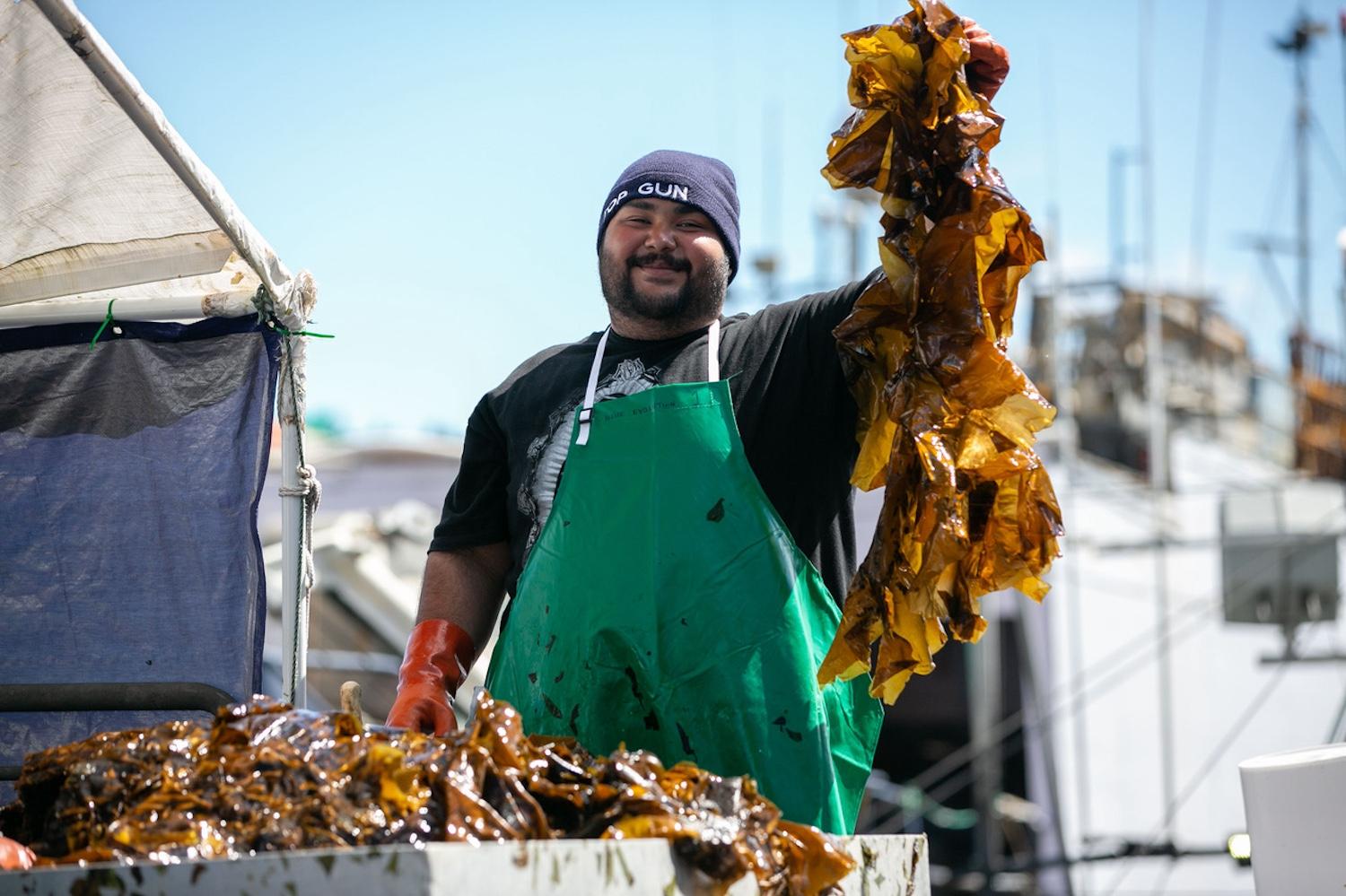
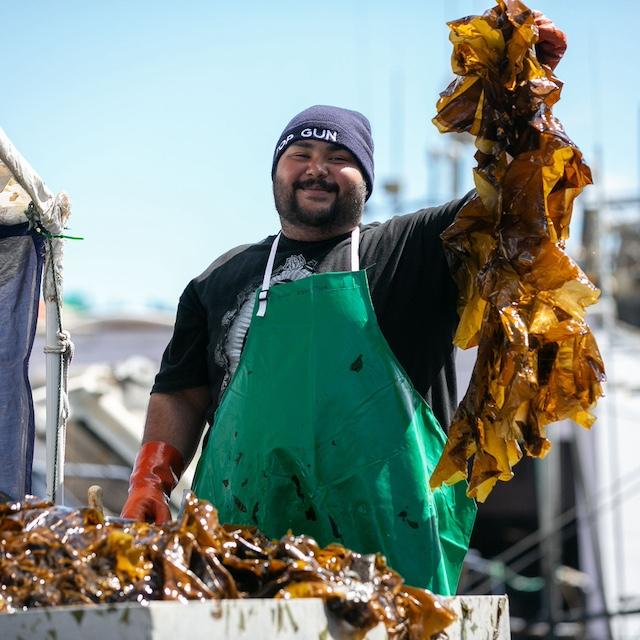
Blue Evolution grows seaweed for wide range of commercial applications, and it could be an effective way to mine minerals. (Image: Rachelle Hacmac for Blue Evolution)
This article is part of our series on responsible mining solutions. The push for clean energy is fueled by growing demand for minerals. Conventional mining has a track record of harmful social and environmental impacts. Phytomining is another potential solution to that problem.
Do you remember “The Giving Tree,” by Shel Silverstein? It’s a children’s book about an apple tree that gives a young boy everything it can, and the boy spends countless hours playing with the tree. As the boy grows older, he has less time for the tree. The tree still provides all it can, but it’s sad that the boy doesn’t visit as much as he used to. The story might make your eyes water, but did you know that the giving tree is alive and well today?
Recently scientists asked the tree for clean, renewable energy. The tree said to them, “I cannot do that. I am a tree.”
The scientists nodded and exchanged intelligent glances. After a few awkward moments, the tree spoke again.
“I cannot provide you with clean, renewable energy, but if you take the critical minerals like nickel and lithium that I accumulate, you can use those to build your renewable energy infrastructure.”
There was a murmur of excitement among the scientists and a chorus of laughter when the most senior among them said, “Talk about green energy!”
Lame joke and talking tree aside, scientists actually discovered that some plants hoard a significant amount of metal. So much so that these plants can contribute to the global supply of critical minerals that power the clean energy transition.
Should I extract metals from the plants in my yard?
Plants consume minerals found in soil like potassium, copper and zinc. Before you run to your garden to taste your plants for metal, know that the average plant does not retain enough to make mining your garden worth the flower destruction.
But there is a special group of plants, called hyperaccumulators, that accumulate high levels of metals. These plants have the attention of scientists, startups and governments. Of the 350,000 known plant species, only about 750 have this hyperaccumulating property.
Hyperaccumulators don’t just grow anywhere, either. They stick to mineral-rich regions. The places they thrive in are often so concentrated with metals that the environment is toxic to other plants.
This lends a clue as to why these plants accumulate metals. For a plant to survive in a region where there are very few, if any, other plants, they need to protect themselves against bugs and animals that are looking for a meal. Hyperaccumulators suck up metal from the soil and transfer it to their above-ground tissues, like their leaves. Animals learn they get severely ill after eating these plants and eventually don’t want to touch them, not to mention the foul metallic taste. Hyperaccumulating metals is largely a defense mechanism.
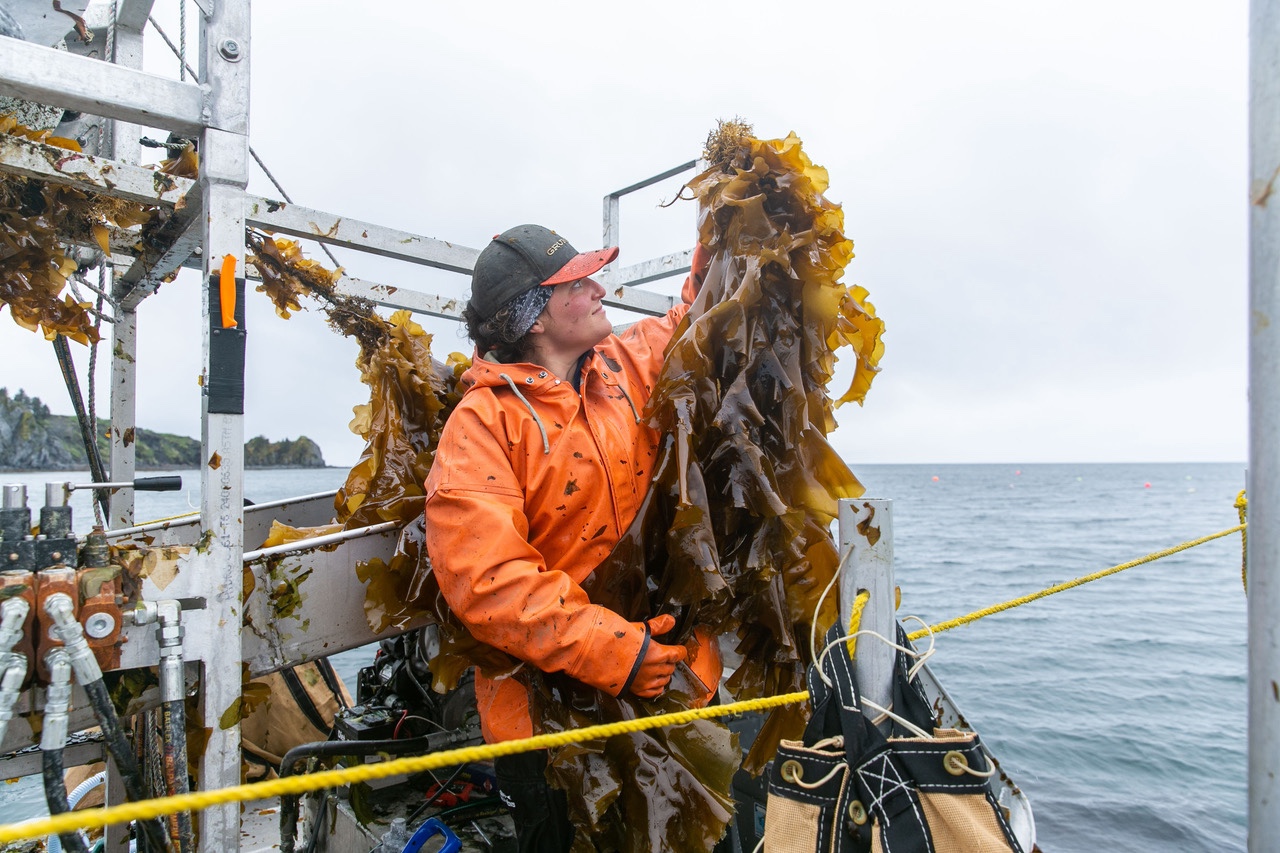
What metals can we mine from hyperaccumulators?
More than two-thirds of the 750 hyperaccumulators that we know of are nickel-lovers. Combine that with the projection that nickel demand is expected to nearly triple by 2040, and this is why the United States Department of Energy, through its Advanced Research Projects Agency-Energy (ARPA-E) office, recently launched a $9.9 million program to explore mining with plants, also known as phytomining. The project focuses on nickel and includes five universities and a few private companies.
“We want to prove that phytomining is economically viable and can have a lower carbon footprint compared with conventional mining,” said Philseok Kim, program director at ARPA-E. “And we have good reason to believe that we can do that.”
Kim estimates that without further advancements in research and development, we could already generate about 18,000 tons of nickel per year from phytomining over 400,000 acres of land, which is about the size of Houston, Texas. That amounts to nearly 10 percent of annual U.S. nickel consumption.
“In the U.S. we have about 10 million acres of serpentine barren land, and if we grew crops on those lands, we probably wouldn’t be comfortable eating them because of the metal content,” Kim said. “So, we have enough land that we aren’t really using for anything.”
Plants that accumulate lithium, zinc, cobalt, copper, and rare earth elements, among other critical minerals, have been identified around the world. While using plants to extract and process minerals is a new field, hyperaccumulators already have some experience in commercial applications.
“Some plants have been commercially used for remediation of environmental impacts of heavy metals,” said Wencai Zhang, associate professor and head of the Sustainable Mineral Technology Laboratory at Virginia Tech. “They call it phytoremediation.”
Did somebody say seaweed?
Let’s leave the comforts of dry land for a moment and head to the beach. One drop of seawater contains traces of most elements known to man. But seawater around some regions, like those close to mines and unique geological features, can have a significantly higher composition of minerals that certain strains of seaweed take a particular liking to.
Blue Evolution is already using seaweed for a surprisingly wide range of commercial applications including construction materials, biopharmaceuticals and cosmetics. The company is now exploring its potential for mineral extraction.
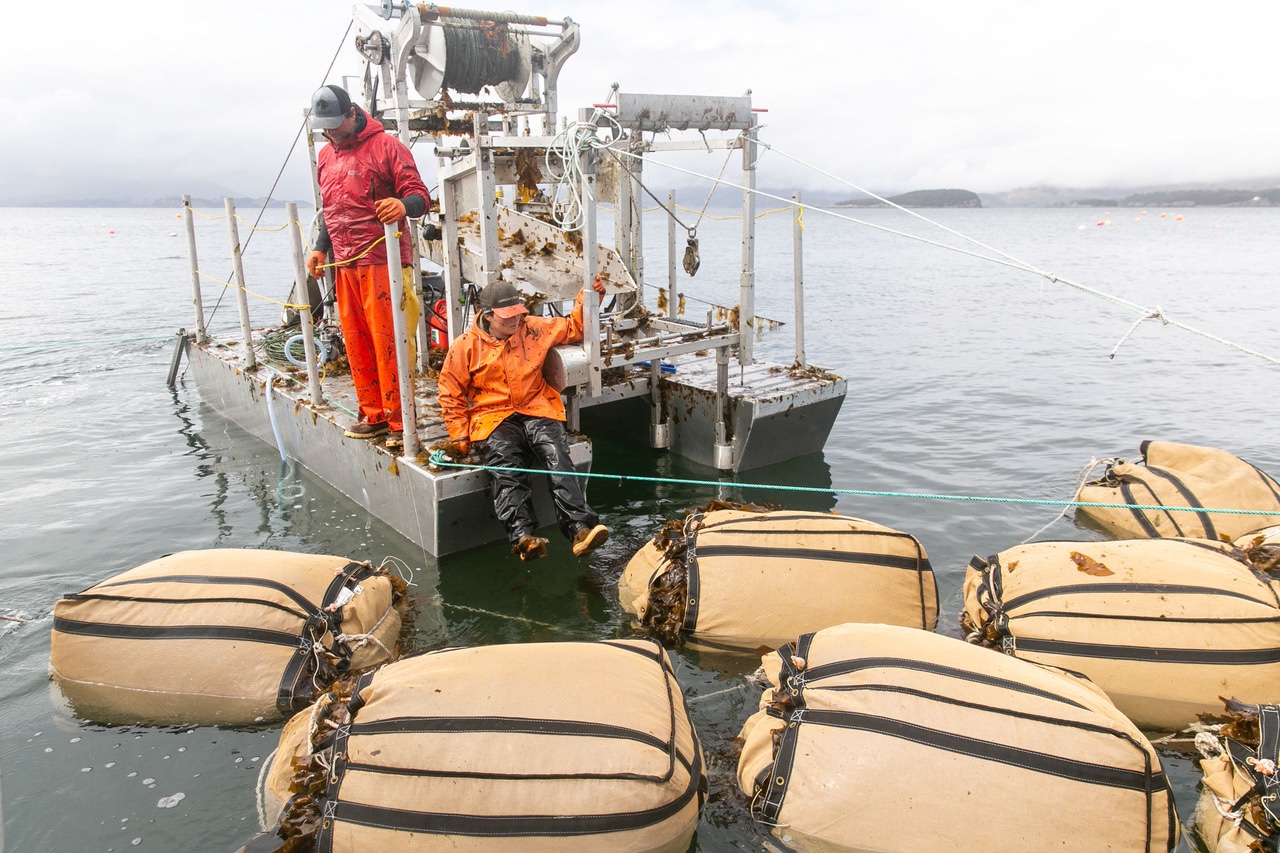
That’s right. The stuff that wraps your sushi rolls can be used to construct buildings, save lives, and now, power renewable energy. But is it actually cost-effective to mine minerals this way?
“If I were only growing seaweed for minerals, yeah, I’d need a lot of extremely cheap biomass,” said Beau Perry, CEO of Blue Evolution. “But we can start with a relatively nominal amount of mineral output and work our way up while balancing that against our other commercial outputs.”
The quantities of minerals collected by seaweed are small, but given the U.S.’s supply concerns with rare earth elements, Blue Evolution may be able to provide a significant source of domestic supply of useful elements like scandium.
“Scandium trades at ten to fifteen tons globally per year, so, you don't have to get a lot of scandium to really change the global supply,” Perry said. “And the other precious metals and rare earth elements are generally the same to varying degrees.”
Blue Evolution is still testing its mineral output capabilities.
Is phytomining the silver bullet?
“I wouldn’t say [it will] compete with conventional mining, but phytomining is going to be a really good, responsible way of supplementing conventional mining,” Kim said.
Plants can only access minerals as far down as their roots go, a maximum of six feet. Their mineral output is limited by what they can access. A mine, on the other hand, can easily reach more than 1,000 feet into the earth.
Recovering the metals from plants also poses some challenges. We can do it, as Kim mentioned, but those methods generally include burning the plant’s organic matter to access and process the mineral-rich ash. This releases carbon dioxide stored in the plant back into the atmosphere, so finding a friendlier recovery method is something that downstream researchers like Virginia Tech’s Zhang are working on.
“If you look outside the U.S. to Indonesia, Malaysia or New Caledonia, there are endemic trees that secrete a green sap which contains like 25 percent nickel,” Kim said. “It would be amazing if we could grow them here, but they are all tropical.”
Other challenges include the general risks of monocropping on a large scale, potentially introducing non-native plants to a region, the volatility of nickel prices, and the challenge of expanding plants’ hyperaccumulator capabilities beyond nickel to other critical minerals.
These challenges are not hard-and-fast inhibitors to phytomining’s commercial success, but rather small obstacles that if resolved, can drastically change the mineral supply landscape of the U.S. and the world.
Scientists asked, and the giving tree responded. All it wants in return is that we spend more time with it like we did in our youth — a reasonable request given all the resources that nature provides us.